|
Electronic Poster Session
Spectroscopy & Non-Proton MR |
Tuesday, 19 June 2018
Electronic PosterSpectroscopy & Non-Proton MR
3840 -3863 Non-Edited MRS/MRSI
3864 -3887 Non-Proton MRS/MRI: Technological Advances
3888 -3911 MRS Applications
3959 -3982 J-Difference-Edited MRS/MRSI
3983 -4006 Non-Proton MRS/MRI: Novel Applications
4007 -4030 Spectroscopy: NMR & Other |
| |
Non-Edited MRS/MRSI
Electronic Poster
Spectroscopy & Non-Proton MR
Tuesday, 19 June 2018
| Exhibition Hall |
08:15 - 09:15 |
| |
|
Computer # |
|
3840.
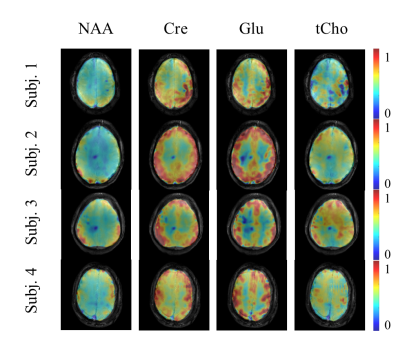 |
49 |
 Over-discretized SENSE reconstruction and B0 correction for accelerated non-lipid suppressed 1H FID MRSI of the human brain at 9.4T Over-discretized SENSE reconstruction and B0 correction for accelerated non-lipid suppressed 1H FID MRSI of the human brain at 9.4T
Sahar Nassirpour, Paul Chang, Anke Henning
In this study the acquisition of high resolution (64x64) metabolite maps at 9.4T using a non-lipid suppressed ultra-short TR and TE 1H FID MRSI sequence is accelerated using an improved over-discretized SENSE reconstruction and B0 correction method. The improved reconstruction is compared to conventional SENSE and GRAPPA reconstruction, and reproducible metabolite maps are acquired using this technique.
|
|
3841.
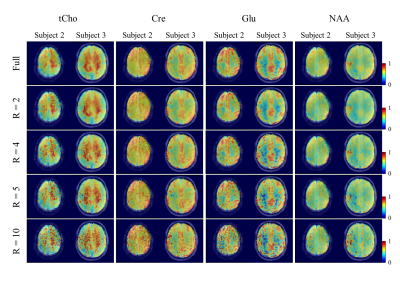 |
50 |
 SNR Requirements for Successful Application of Compressed Sensing Acceleration to Non-lipid suppressed 1H MRSI at Ultra-High Fields SNR Requirements for Successful Application of Compressed Sensing Acceleration to Non-lipid suppressed 1H MRSI at Ultra-High Fields
Sahar Nassirpour, Paul Chang, Nikolai Avdievitch, Anke Henning
In this work we systematically investigate the requirements for successful application of compressed sensing for highly accelerating the acquisition of non-lipid suppressed 1H FID MRSI data at ultra-high fields. It is shown that with a combination of parallel imaging and sparse reconstruction, and an RF coil with an even distribution of receive sensitivity, highly accelerated and high resolution metabolite maps can be acquired at 9.4T through compressed sensing.
|
|
3842.
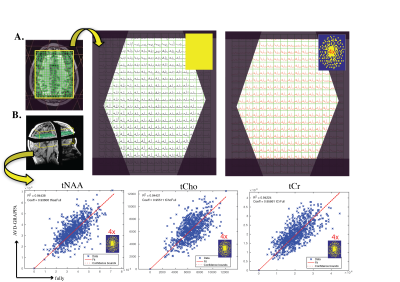 |
51 |
 Arbitrary Variable Density (AVD)-GRAPPA Enabled EPSI of Short-echo 3D H1-MRSI Arbitrary Variable Density (AVD)-GRAPPA Enabled EPSI of Short-echo 3D H1-MRSI
Maryam Vareth, Yan Li, Misung Han, Marram Olson, Jason Crane, Sarah Nelson, Janine Lupo
This work investigates the feasibility of using arbitrary sampling patterns and GRAPPA-EPSI reconstruction to shorten the acquisition time and increase the spatial resolution of short-echo 3D-MRSI for routine clinical purposes. Fully sampled data were retrospectively under-sampled to achieve effective acceleration rates of 2, 3 and 4 using a variety of sampling patterns. The modified GRAPPA algorithm: 1) took advantage of the FID time points, 2) handled arbitrary sampling patterns, and 3) used a fast, high-resolution external calibration acquisition to estimate sensitivity maps.
|
|
3843.
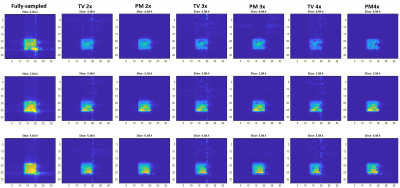 |
52 |
 Comparison of Compressed Sensing Reconstruction for 3D Echo Planar Spectroscopic Imaging data using Total Variation and Statistically Optimized Perona-Malik Non-linear Diffusion Comparison of Compressed Sensing Reconstruction for 3D Echo Planar Spectroscopic Imaging data using Total Variation and Statistically Optimized Perona-Malik Non-linear Diffusion
Andres Saucedo, Ajin Joy, Eric Daar, Mario Guerrero, Joseph Paul, Manoj Sarma, M. Albert Thomas
Conventional magnetic resonance spectroscopic imaging requires long acquisition times. Echo planar spectroscopic imaging (EPSI) significantly reduces the scan time but is limited by conventional phase encoding. Non-uniform sampling and compressed sensing (CS) reconstruction can further accelerated 3D EPSI. We applied a Perona-Malik (PM) non-linear diffusion algorithm for CS reconstruction of 3D EPSI data in both retrospectively and prospectively undersampled phantom and in-vivo data sets, and compared results with those using Total Variation (TV). Our pilot findings demonstrate that PM produces improved reconstruction results compared to TV. Furthermore, PM eliminates the need for parameter tuning, giving it a great advantage over TV.
|
|
3844.
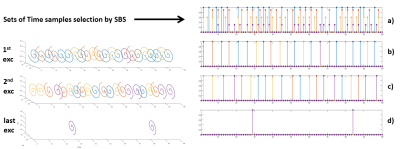 |
53 |
 Fast Irregular MRSI spiral acquisition for sparse spectra. Application to 31P MRSI in muscles. Fast Irregular MRSI spiral acquisition for sparse spectra. Application to 31P MRSI in muscles.
Jabrane Karkouri, Fabien Millioz, Magalie Viallon, Rémy Prost, Hélčne Ratiney
Magnetic resonance spectroscopic imaging (MRSI) has multiple interests in clinical practice but it faces quite long acquisition time in practice which limits its use in a clinical environment. In this work, a new fast Magnetic Resonance Spectroscopic image acquisition method, inspired by Compressed Sensing using the a priori known sparse support of the metabolites chemical shift, is introduced and evaluated based on a k-t space spiral sampling. In the proposed method, the spatial and temporal interleaves are both taken in consideration during the implementation, in order to reach an even faster acquisition. This method has been evaluated using real in vivo 31P data.
|
|
3845.
 |
54 |
Residual water signal removal in MR spectroscopic imaging with L2 regularization
Video Permission Withheld
Liangjie Lin, Michal Povaz?an, Adam Berrington, Zhong Chen, Peter Barker
Residual water signals in MRSI data may hinder the quantification of metabolite signals and thus affect the quality of final metabolite maps. A L2 regularization based post-processing method is proposed here for efficient removal of residual water signals especially in MRSI data. Using a water-basis matrix, the proposed method aims to find spectra that match the original metabolite signals, but at the same time imposes a constraint of reduced water signals. Results show that the L2 regularization based method can be a highly effective way for removing residual water signals from MRSI data of human brain.
|
|
3846.
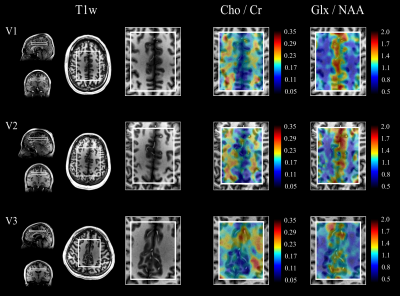 |
55 |
 High Resolution Semi-LASER Localized Echo Planar Spectroscopic Imaging at Ultra High Field High Resolution Semi-LASER Localized Echo Planar Spectroscopic Imaging at Ultra High Field
Eduardo Coello, Ralph Noeske, Brian Burns, Jeremy Gordon, Angela Jakary, Bjoern Menze, Axel Haase, Peder Larson, Yan Li, Rolf Schulte
This work presents a robust framework for fast high-resolution 1H MRSI at 7 Tesla using semi-localized by adiabatic selective refocusing (semi-LASER) and high-bandwidth symmetric echo planar spectroscopic imaging (EPSI). Inconsistencies in the symmetric EPSI trajectory are corrected using a single shot water reference scan, effectively removing spectral ghosting. With the proposed methodology, high-resolution metabolite ratio maps that show correlation with anatomical structures were obtained under 5-minutes.
|
|
3847.
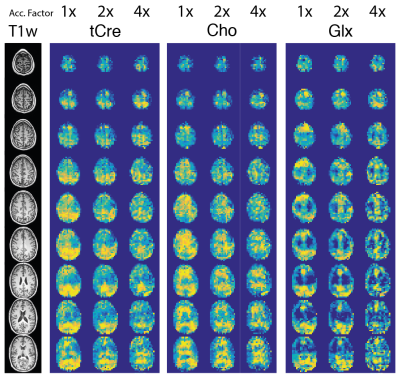 |
56 |
 Whole Brain 5mm-isotropic 3D 1H-FID-MRSI accelerated with Compressed-Sensing SENSE Whole Brain 5mm-isotropic 3D 1H-FID-MRSI accelerated with Compressed-Sensing SENSE
Antoine Klauser, Sebastien Courvoisier, Michel Kocher, Dimitri Van De Ville, Francois Lazeyras
Proton FID-MRSI sequence was implemented in 3D to measure metabolite distributions over whole brain up to 5mm-isotropic resolution. MRSI dataset was reconstructed through a Low-Rank-TGV model enabling Compressed-sensing SENSE acceleration. Acceleration performance was assessed quantitatively on a-posteriori 6.6mm-isotropic dataset showing good agreement up to a factor 2. As proof of concept, metabolite images of a 5mm-isotropic dataset accelerated by a factor 2 were acquired and reconstructed.
|
|
3848.
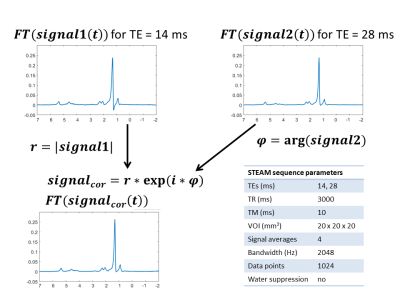 |
57 |
 Effect of the phase variation induced by eddy currents on localized spectroscopy fatty acid composition quantification and its correction Effect of the phase variation induced by eddy currents on localized spectroscopy fatty acid composition quantification and its correction
Angéline Nemeth, Benjamin Leporq, Amandine Coum, Giulio Gambarota, Kévin Seyssel, Bérénice Segrestin, Pierre-Jean Valette, Martine Laville, Olivier Beuf, Hélčne Ratiney
Monte Carlo simulations and in vivo measurements on human abdominal adipose tissue were used to analyze the effect of the phase variation induced by eddy currents on localized spectroscopy fatty acid composition quantification (proportion of polyunsaturated, monounsaturated and saturated fatty acid). Monte Carlo simulations showed that base line distortions were able to strongly impact estimation of fatty acid composition. So we proposed a simple method to correct the base line using a second signal acquired with a longer TE. Test-retest variability of quantitative results was reduced using this correction.
|
|
3849.
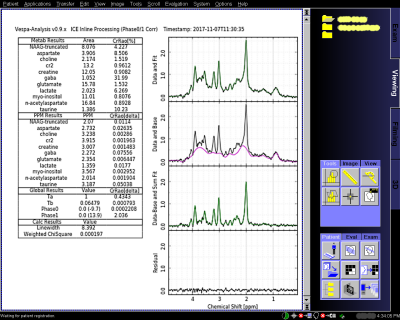 |
58 |
 IceVespa: Automated Inline MR Spectral Processing and Fitting on the Clinical Platform IceVespa: Automated Inline MR Spectral Processing and Fitting on the Clinical Platform
Brian Soher, James Joers, Dinesh Deelchand, Gulin Oz
The IceVespa module is a flexible add-in functor for the Siemens IceProgramF ICE pipeline for MRS data. Raw MRS data is sent to a Python-based Vespa-Analysis spectral processing node via an XML-RPC client/server. Graphical and tabular spectral analysis fitting results are returned to the ICE pipeline and saved in the standard DICOM workflow. Analysis executes in its own process. XML-RPC was chosen for inter-process communication for its simplicity and flexibility for relocating the processing node using standard HTTP protocols. Combining Python-based IceVespa inline with standard C++ ICE processing increases processing algorithm choice while maintaining clinical access to quantitative MRS measures.
|
|
3850.
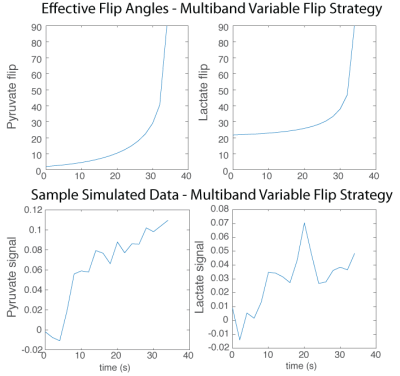 |
59 |
 Analysis Methods for Human Hyperpolarized 13C-pyruvate Studies Analysis Methods for Human Hyperpolarized 13C-pyruvate Studies
Peder Larson, Hsin-Yu Chen, Jeremy Gordon, John Maidens, Daniele Mammoli, Mark Van Criekinge, Robert Bok, Rahul Aggarwal, Marcus Ferrone, James Slater, John Kurhanewicz, Daniel Vigneron
A major challenge for human Hyperpolarized 13C metabolic MRI is to develop informative, accurate and robust methods for measuring metabolic conversion, while accounting for a broad range of experimental characteristics and without gold-standard experiments for evaluating accuracy and precision. We present a simulation framework to evaluate analysis strategies and show that an “input-less” kPL fitting method is a promising approach for accurate and robust measurements of metabolism in human hyperpolarized 13C-pyruvate MRI. We evaluate this method in human prostate cancer studies, where we observed variability of ±5-10s in the bolus delivery that can lead to errors in other analysis methods.
|
|
3851.
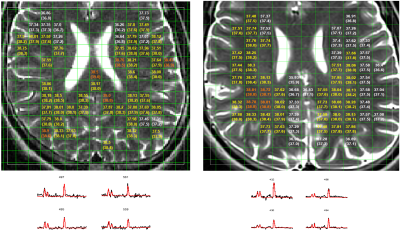 |
60 |
 MRSI Brain Temperature Mapping Using Machine Learning MRSI Brain Temperature Mapping Using Machine Learning
Dhritiman Das, Michael Thrippleton, Scott Semple, Rolf Schulte, Mike Davies, Bjoern Menze, Ian Marshall
We propose a machine-learning framework for brain temperature estimation in MRSI using human in-vivo data from 1.5T and 3T scanners. We consider the chemical-shift based method as our benchmark and compare our results against it. Our framework, based on random-forest regression, performs a K-fold cross validation on the MRSI dataset which includes (1) learning the spectral features (including the chemical-shift) from the subjects; (2) obtaining brain temperature estimates and computing the error over the corresponding jMRUI-fitted chemical-shift based estimates. Compared to jMRUI, our method, after training, gives a low estimation error and a 30-fold improvement in estimation speed per patient.
|
|
3852.
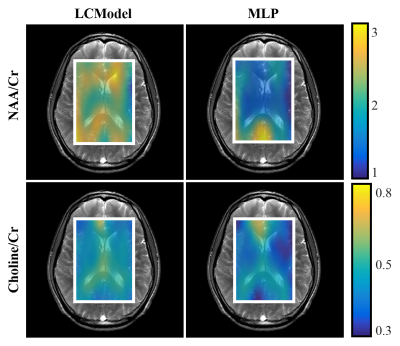 |
61 |
 Direct Estimation of Model Parameters in MR Spectroscopic Imaging using Deep Neural Networks Direct Estimation of Model Parameters in MR Spectroscopic Imaging using Deep Neural Networks
Dhritiman Das, Eduardo Coello, Anjany Sekuboyina, Rolf Schulte, Bjoern Menze
We introduce a deep neural-network framework based on a multilayer perceptron for estimation of the output parameters of a model-based analysis of MR spectroscopy data. Our proposed framework: (1) learns the spectral features from a training set comprising of different variations of synthetic spectra; (2) uses this learning and performs non-linear regression for the subsequent metabolite quantification. Experiments involve training and testing on simulated and in-vivo human brain spectra. We estimate parameters such as metabolite-concentration ratios and compare our results with that from the LCModel.
|
|
3853.
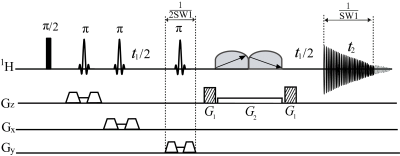 |
62 |
 Spatially localized pure shift 1H MRS for biological tissues at 7 T Spatially localized pure shift 1H MRS for biological tissues at 7 T
Yuqing Huang, Weinan Lai, Zhong Chen
Proton magnetic resonance spectroscopy (1H MRS) presents an effective tool for in vivo studies on biological tissues by the non-invasive detection manner. However, due to limited proton chemical shift range and extensive J coupling splittings, spectral congestions or even overlapping are generally encountered in resulting 1D 1H MRS acquired by routine STimulated Echo Acquisition Mode (STEAM) and Point resolved spectroscopy (PRESS) experiments. In this report, we presents a previously-unreported MAS approach to obtain spatially localized 1D pure shift spectra with spectral simplification, potentially useful for studies on biological samples.
|
|
3854.
 |
63 |
 HOPE (Half-intensity with macrOmolecule-suPprEssion): Ultra-short TE MRS without macromolecules on 3 T, 4 T and 9.4 T HOPE (Half-intensity with macrOmolecule-suPprEssion): Ultra-short TE MRS without macromolecules on 3 T, 4 T and 9.4 T
Xi Chen, Yihong Yang, Dost Ongur, Fei Du
The strong and overlapping macromolecule (MM) signals remains as one of the major technical challenges for metabolites quantification using ultra-short TE MRS. HOPE (Half-intensity with macrOmolecule-suPprEssion), a simple but effective MM suppression MRS method based on SPECIAL, was proposed and tested on human 3T, 4T and animal 9.4T. HOPE has no additional pulse or cycling compared to SPECIAL but with the same short TE. With the similar SNR level as STEAM, HOPE achieves additional benefit with substantial suppression of MM signals and more accurate quantifications of MM overlapped metabolites such as lactate and GABA.
|
|
3855.
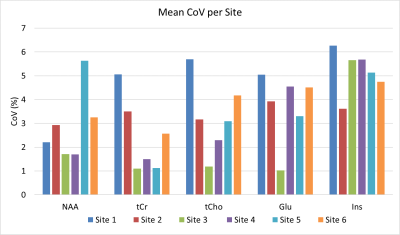 |
64 |
Intra- and inter-site reproducibility of single voxel MRS at 3T in the human brain
Video Permission Withheld
Carina Graf, Erin MacMillan, Eric Fu, Irene Vavasour, Trudy Harris, Burkhard Mädler, Anthony Traboulsee, David Li, Alex MacKay, Cornelia Laule
We investigated the intra- and inter-site reproducibility of 1H-MRS with short-TE PRESS at 3T acquired on a single manufacturer at 6 different sites. Metabolite concentrations were robust to small inconsistencies in voxel placement (mean alignment=86%), highlighting that site was not the driving factor for differences in metabolite concentrations. Between-subject differences drove the concentration variability for creatine, choline and myoinositol (42-65% of the variance). The mean intra-site coefficient of variation for the metabolites was between 2.5% and 5.3%. The results support the use of a large single voxel 1H-MRS acquisition from a single manufacturer for multi-site clinical trials.
|
|
3856.
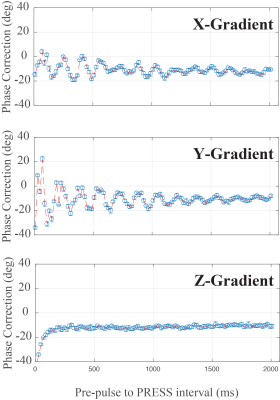 |
65 |
 Eddy current evaluation and minimization for PRESS localized diffusion tensor spectroscopy. Eddy current evaluation and minimization for PRESS localized diffusion tensor spectroscopy.
Chris Hanstock, Christian Beaulieu
Gradients used for diffusion spectroscopy require minimization of the eddy currents. Eddy currents impact phase alignment, spectral distortion, and signal amplitude, contributing to error in estimating diffusion coefficients. Strategies have been employed to minimize their effects, including using bipolar gradient pulses around the MRS volume selective pulses. This concept has been further refined to allow multiple eddy current time constants to be minimized by using asymmetric bipolar gradient pairs. An additional oscillatory eddy current may arise as the result of vibration and acoustic noise. We present a simple method for assessing and minimizing the oscillatory eddy currents.
|
|
3857.
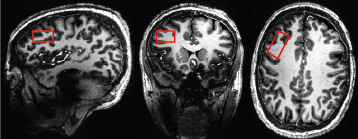 |
66 |
Evaluation of accuracy and reproducibility of 1H MRS measurements of lactate at 7 T
Video Permission Withheld
Masoumeh Dehghani, Kim Q. Do , Pierre Magistretti, Lijing Xin
Lactate is known as an end-product of aerobic glycolysis, and it has been considered as a potential biomarker of metabolic abnormalities occurred in different cerebral pathological states. However, the 1H MRS detection of lactate is hampered by the presence of co-resonant lipid and macromolecule resonances. The aim of this study was to evaluate the performance of different 1H MRS protocols applied in semi-adiabatic spin-echo full-intensity acquired localized spectroscopy sequence, I) TE=16 ms, no inversion, II) TE=16 ms, TI= 300 ms, and III) TE=110 ms, no inversion in reliable detection of lactate in the brain using in vivo measurement and simulated spectra at different experimental condition. The in vivo measurement and simulation analysis suggests that short-TE 1H MRS approach without inversion pulse is likely to be a more reliable method for estimating the absolute concentration of lactate and other metabolites simultaneously from the human brain.
|
|
3858.
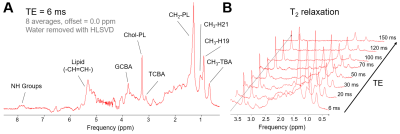 |
67 |
Quantification and Assessment of T2 Relaxation Times of Human Bile Components with In Vivo MR Spectroscopy at 7T
Video Permission Withheld
Martin Gajdošík, Marek Chmelík, Emina Halilbasic, Lorenz Pfleger, Michael Trauner, Siegfried Trattnig, Martin Krššák
In vivo measurements of concentrations of bile components are of high interest for understanding and diagnosis of cholestatic diseases. We measured human bile in the gallbladder in vivo using single-voxel 1H-MR spectroscopy at 7T and assessed T2 relaxation times of water and eight bile components in healthy volunteers. With precise T2 correction, all eight bile components could be quantified with ultra-short TE sequence and four with long TE sequence.
|
|
3859.
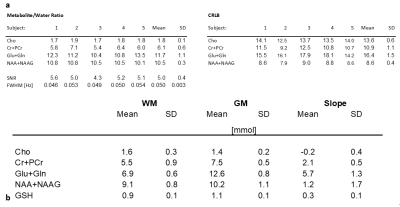 |
68 |
 A 3 Minute Clinical Protocol for Quantitative High-Speed MR Spectroscopic Imaging in Patients with Brain Tumors A 3 Minute Clinical Protocol for Quantitative High-Speed MR Spectroscopic Imaging in Patients with Brain Tumors
Troy Hutchins-Delgado, Mohammad Chohan, Kevin Fotso, Lakshmisree Damodaran, Howard Yonas, Mona Chaney, Stefan Posse
We develop a quantitative 3-minute 3D short echo-time (TE) proton-echo-planar-spectroscopic-imaging (PEPSI) protocol. The short scan time is made possible by using partial brain coverage that encompasses the tumor and integration of the water reference (WR) scan into the water suppression module, which enables short repetition time. The method was validated in 5 healthy controls and applied to mapping tumor margins and infiltration in 3 patients with brain tumors. Slab-averaged metabolite/water ratios varied by less than 10% between healthy controls and metabolite concentration values after partial volume and relaxation correction were in the range of our previous study.
|
|
3860.
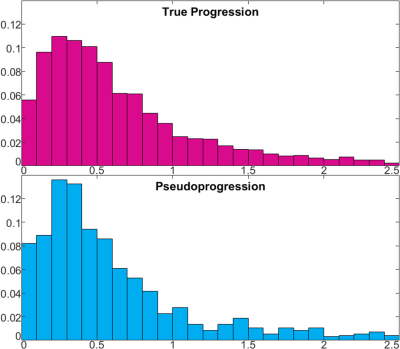 |
69 |
 Assessment of metabolic heterogeneity in glioblastoma multiforme (GBM) through histogram analysis of whole-brain echo planar spectroscopic imaging Assessment of metabolic heterogeneity in glioblastoma multiforme (GBM) through histogram analysis of whole-brain echo planar spectroscopic imaging
Gaurav Verma, Sanjeev Chawla, Suyash Mohan, Sumei Wang, Rebecca Feldman, MacLean Nasrallah, Steven Brem, Donald O'Rourke, Harish Poptani, Priti Balchandani
Glioblastoma multiforme (GBM) is an infiltrating and heterogeneous disease with low median survival and over 70% recurrence rates, though 20-30% of progressive enhancing lesions seen in GBM post-treatment exhibit pseudoprogression rather than true recurrent tumor. Differentiating these could improve speed and accuracy of treatment. A statistical and histogram analysis of segmented high-resolution echo-planar spectroscopic imaging data goes beyond mean metabolite ratios to show distribution of Cho/NAA and Cho/Cr ratios in contrast enhancing regions and the surrounding tissue. Cho/NAA distribution in enhancing region showed greater kurtosis than Cho/Cr, suggesting reduction in NAA may be a driving factor in observed Cho/NAA increases.
|
|
3861.
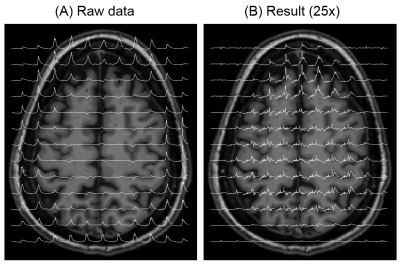 |
70 |
Cross-validated full-field of view MRSI using a new spatial lipid extraction technique and HSVD and PG algorithms in the human brain.
Video Permission Withheld
Peter Adany, In-Young Choi, Phil Lee
Reliable 1H MRS measurement in the brain is challenging due to strong lipid signals as high as two orders of magnitude stronger than metabolites. We propose a new spatial-domain post processing technique to extract the lipid signal and compare our method with the HSVD and PG algorithms applied to full field of view (FOV) MRSI data (no lipid nulling, no outer volume suppression). Results of lipid removal were assessed visually and by spectral quantification of MRSI voxels for N=9 subjects. Our method outperformed HSVD and PG and achieved reliable full-FOV MRSI, promising to reach the maximum potential of whole-brain MRSI.
|
|
3862.
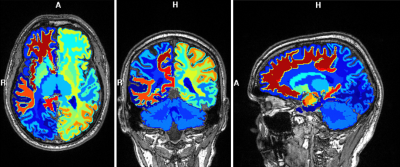 |
71 |
High resolution 3D EPSI Spectroscopic Imaging compared with Spectral Localization by Imaging (SLIM)
Video Permission Withheld
Sean Ellis, Peter Adany, Phil Lee, In-Young Choi
Quantitative measurements of metabolites in important structures in the human brain are challenging to acquire using conventional spectroscopic imaging methods. In this study, we compared regional metabolite concentrations obtained from high resolution 3D EPSI MRSI data using two different methods: spatial averaging inside regions of interest using the MIDAS software, and Spectral Localization by Imaging (SLIM)-based MRS. Deep brain structures were studied and compared using the two methods. The quantitative outcomes of 3D EPSI and SLIM were comparable and SLIM could provide metabolite concentrations using shorter scan times by reducing the required number of voxel acquisitions.
|
|
3863.
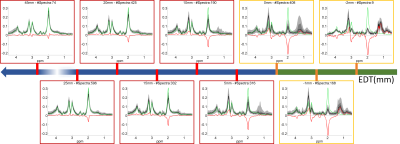 |
72 |
 MRSI-based characterization of GBM using a novel map: Expected Distance to Tumor (EDT) MRSI-based characterization of GBM using a novel map: Expected Distance to Tumor (EDT)
Nuno Pedrosa de Barros, Raphael Meier, Samuel Stettler, Urspeter Knecht, Evelyn Herrmann, Philippe Schucht, Mauricio Reyes, Jan Gralla, Roland Wiest, Johannes Slotboom
MRSI can detect regions of brain tumor infiltration beyond the tumor borders visible in structural-MRI (sMRI). However, this is often achieved using only a small fraction of the information provided by MRSI, namely Cho/NAA maps only. Here, we present a new machine-learning-based approach that translates the multidimensional information provided by each spectrum into a single measure: the Expected Distance to solid Tumor volume visible in sMRI. The results show that peritumoral spectra carry information on the distance to solid tumor and that EDT maps may improve the characterization of peritumoral tissue changes invisible with structural MRI.
|
|
Non-Proton MRS/MRI: Technological Advances
Electronic Poster
Spectroscopy & Non-Proton MR
Tuesday, 19 June 2018
| Exhibition Hall |
08:15 - 09:15 |
| |
|
Computer # |
|
3864.
 |
73 |
 Assessment of Bound Sodium using Triple Quantum Selection vs. Inversion Recovery at 21.1 T Assessment of Bound Sodium using Triple Quantum Selection vs. Inversion Recovery at 21.1 T
Nastaren Abad, Ghoncheh Amouzandeh, Jens Rosenberg, Michael Harrington, Samuel Grant
This study evaluates Triple Quantum (TQ) and Inversion Recovery (IR) techniques at 21.1 T with regards to bound sodium quantification. Using both gel phantoms imitating physiological concentrations/bound fractions as well as in vivo animal pathological models, the efficiency, SNR and selectivity of 23Na TQ and IR techniques were compared with the ultimate goal of localizing specific sodium changes within intra- and extracellular compartments related to disease progression.
|
|
3865.
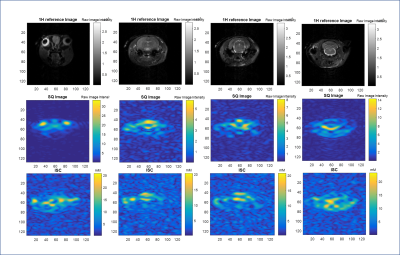 |
74 |
 Investigating Bound Sodium Signals using a Novel Chemical Shift Imaging Triple Quantum Technique Investigating Bound Sodium Signals using a Novel Chemical Shift Imaging Triple Quantum Technique
Nastaren Abad, Ghoncheh Amouzandeh, Jens Rosenberg, Michael Harrington, Samuel Grant
23Na-based MRI techniques can be used to separate sodium signal originating from the extracellular and intracellular compartments. Triple Quantum (TQ) schemes can select the coherence pathway that evolves in slow moving/restricted regimes, such as in the intracellular compartment. In this study, a novel TQ technique based on a modified chemical shift imaging sequence (CSI-TQ), which yields higher signal-to-noise ratios, is introduced for studies at 21.1 T. The CSI-TQ is compared to a more conventional gradient recalled echo variant (GRE-TQ) with respect to SNR and efficiency.
|
|
3866.
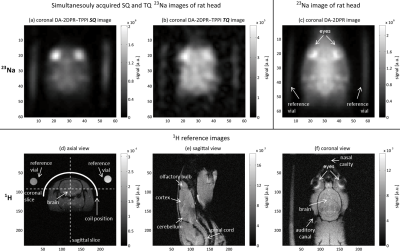 |
75 |
 Simultaneously Acquired Single- and Triple-Quantum Spectroscopic Imaging with Density-Adapted Projection Reconstruction and Time Proportional Phase Increment Simultaneously Acquired Single- and Triple-Quantum Spectroscopic Imaging with Density-Adapted Projection Reconstruction and Time Proportional Phase Increment
Ruomin Hu, Matthias Malzacher, Michaela Hoesl, Dennis Kleimaier, Lothar Schad
Multi-quantum filtered spectroscopic imaging methods utilize the spin-3/2 characteristic of 23Na nuclei to generate multi-quantum coherences reflecting on the binding of 23Na+ to macromolecules. In this work, a spectroscopic density-adapted radial imaging modality was developed to simultaneously acquire single-quantum and triple-quantum signal under identical condition using time proportional phase increments. In vivo rat head images with 1 mm resolution were acquired in under an hour. This method may be applied to monitor the single-quantum and triple-quantum signal development in diseases such as stroke and cancer and lead to a deeper understanding of metabolic processes in healthy and diseased tissue.
|
|
3867.
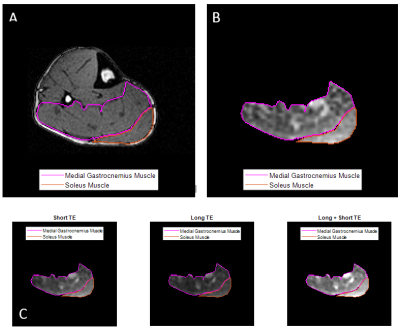 |
76 |
 Sodium imaging with an UTE technique to study the effects of exercise on muscle. Sodium imaging with an UTE technique to study the effects of exercise on muscle.
Benjamin Prestwich, Charlotte Buchanan, Andrew Hale, Andrew Peters, Susan Francis
Sodium (23Na) imaging can provide insight into the effects of exercise on muscle. Here we perform a 3D dual TE UTE scheme with radial FID readout to assess the alterations in sodium tissue concentration in the gastrocnemius and soleus muscles; immediately after exercise performed inside the scanner using a Trispect pedal system. In addition an mDIXON proton scan was acquired for delineation of the muscle groups. Following exercise, the time course of the 23Na signal intensity in the medial gastrocnemius and soleus muscles was found to return to baseline after approximately 30 minutes, with a 10 – 20 % signal change.
|
|
3868.
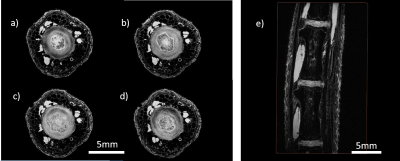 |
77 |
 Design of a Dual Saddle Coil Setup for High Resolution 1H/23Na MRI of Ex Vivo Rat Tail Intervertebral Discs at 14.1T Design of a Dual Saddle Coil Setup for High Resolution 1H/23Na MRI of Ex Vivo Rat Tail Intervertebral Discs at 14.1T
Lance Williams, John Clark, Lukas Neuberger, Gangchea Lee, Daniel Cortes, Thomas Neuberger
Rat-tail intervertebral disc puncture is a commonly used model for studying treatment options and the pathology of Degenerative Disc Disease (DDD). However, longitudinal studies are impossible as analysis through biochemistry and histology requires euthanization. High-field MRI provides a possible solution to this problem as initial structural and compositional changes related to disc degeneration are observable. In this work, a dual saddle coil was constructed for 1H/23Na imaging at 14.1T. It was concluded from ex vivo rat-tail proton and sodium images that sodium MRI is feasible, and it could be an effective method for rat-tail intervertebral disc degeneration evaluation.
|
|
3869.
 |
78 |
 Effect of B0 and B1 Field Inhomogeneity Correction on Region-of-Interest Analysis on 3T Sodium 23Na-MRI Effect of B0 and B1 Field Inhomogeneity Correction on Region-of-Interest Analysis on 3T Sodium 23Na-MRI
Elaine Lui, Vijay Venkatraman, Christopher Steward, Tie-Qiang Li, Patricia Desmond
Evaluation of the effect of B0 and B1 correction on region-of-interest (ROI) analysis in forty-one 3T brain 23Na-MRI scans shows average change from B0, B1 and B0B1 correction of 1.0% (p=0.05), -3.7% (p<0.001) and -4.7% (p<0.001) respectively. Effect is more for B1 than B0 correction, and depending on the anticipated effect size of the neurologic disease of interest, B0 +/- B1 correction may not be required, potentially reducing scan time by 66% and thus encourage quantitative 23Na-MRI research in a clinical environment.
|
|
3870.
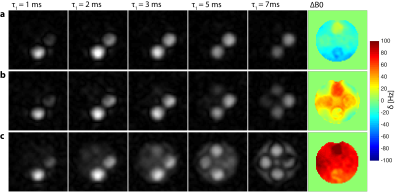 |
79 |
 Double quantum filtered 23Na MRI with magic angle excitation in presence of B0-inhomogeneities Double quantum filtered 23Na MRI with magic angle excitation in presence of B0-inhomogeneities
Lena Gast, Bernhard Hensel, Michael Uder, Armin Nagel
In 23Na MRI it is possible to selectively detect signal from sodium ions bound to anisotropic structures by applying a double quantum filter with magic angle excitation (DQ-MA). In this work, the influence of B0-inhomogeneities on the DQ-MA filtering capacity was examined both theoretically and experimentally. We found that under practical conditions (|ΔB0| ≈ 50 Hz at 3T) a significant amount of unwanted odd rank double quantum coherence signal may pass the filter even in case of perfect magic angle excitation. Therefore, B0-inhomogeneities may cause an over-estimation of the degree of anisotropy.
|
|
3871.
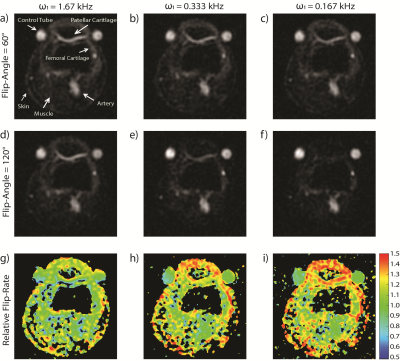 |
80 |
Investigating the 23Na Flip-Angle Effect in Cartilage, Skin, and Muscle
Video Permission Withheld
Atefeh Kordzadeh, Jade Duchscherer, Christian Beaulieu, Robert Stobbe
The measurement of sodium concentration in cartilage, skin, and muscle with 23Na MRI requires the knowledge and minimization of spin 3/2-related signal losses. Here, a common B1 mapping experiment is used here to show that greater than prescribed flip-angles are produced in healthy human cartilage, skin, and muscle and that this effect is increased with longer RF excitation pulses. This points to the presence of residual quadrupole interactions in these tissues. To avoid the concomitant signal loss associated with residual quadrupole interactions, very hard (short) RF excitation pulses may be required.
|
|
3872.
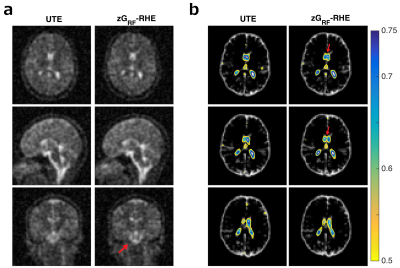 |
81 |
 Improved Encoding Efficiency in Sodium MRI with Zero-Gradient-Excitation Ramped Hybrid Encoding (zGRF-RHE) Improved Encoding Efficiency in Sodium MRI with Zero-Gradient-Excitation Ramped Hybrid Encoding (zGRF-RHE)
Yasmin Blunck, Bradford Moffat, Scott Kolbe, Roger Ordidge, Jon Cleary, Leigh Johnston
The fast signal decay in sodium MRI makes high quality image acquisition challenging. Here we enhance image quality by improving encoding time (tenc) efficiency using a special case of ramped hybrid encoding , zero-gradient-under-RF-excitation RHE (zGRF-RHE). This provides 1) gradient-free-excitation for high flip angle, non-selective excitation profiles necessitated by low signal in sodium MRI and 2) gradient ramping during deadtime for optimised tenc, to reduce T2 decay influence during acquisition. The performance of zGRF-RHE is demonstrated in simulations, phantom and in vivo experiments and improves image quality (SNR and T2 blurring). It is applicable to any centre-out trajectory design.
|
|
3873.
 |
82 |
 Influence of motion and partial volume effects on measured tissue sodium concentration in cardiac $$$^{23}$$$Na MRI Influence of motion and partial volume effects on measured tissue sodium concentration in cardiac $$$^{23}$$$Na MRI
Johanna Lott, Jonathan M. Lommen, Sebastian C. Niesporek, Tanja Platt, Nicolas G.R. Behl, Mark E. Ladd, Armin M. Nagel
Sodium (23Na) ions are involved in many biological processes. The tissue sodium concentration can be determined with 23Na MRI; however, fast relaxation times, breathing and heart motion as well as the high sodium concentration of blood render quantitative determination of the myocardial sodium concentration challenging. We present a method to analyze the tissue sodium concentration within the myocardium by utilizing a partial volume correction as well as correction of motion effects. The presented workflow can reduce the bias by up to 49%.
|
|
3874.
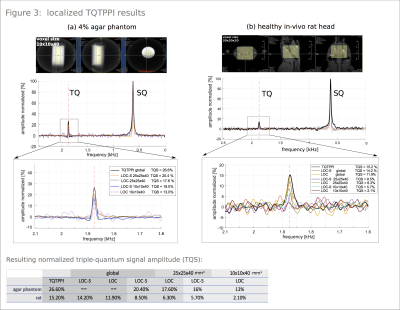 |
83 |
 Voxel localization for sodium NMR triple-quantum signal; sequence design and test in agarose phantoms and in-vivo rat Voxel localization for sodium NMR triple-quantum signal; sequence design and test in agarose phantoms and in-vivo rat
Michaela Hoesl, Dennis Kleimaier, Matthias Malzacher, Ruomin Hu, Lothar Schad
The TQTPPI – sequence is a global spectroscopic method, which can be used to study the sodium metabolism of cells in-vitro with the foremost interest in the occurrence of the triple-quantum signal. This spectroscopic analysis could offer precise knowledge of sodium metabolic processes in pathology versus healthy tissue. To address clinical questions, we aim for transferring this method to in-vivo patient acquisitions where the need for a localization arises. Two different localization strategies, which preserve the quantum coherences, were successfully implemented and tested in-vitro and in-vivo on a rat using a 9.4T small-animal scanner.
|
|
3875.
 |
84 |
 Can sodium triple-quantum signal separate extra- and intracellular signals? – investigation on HEP G2 liver cells, liposomes and nanoparticles Can sodium triple-quantum signal separate extra- and intracellular signals? – investigation on HEP G2 liver cells, liposomes and nanoparticles
Michaela Hoesl, Dennis Kleimaier, Ruomin Hu, Matthias Malzacher, Eric Gottwald, Cordula Nies, Lothar Schad
Sodium MRI is increasing in popularity albeit the apparent challenges of low SNR and fast bi-exponential decay. Currently, intra- and extra cellular sodium can only be resolved by introducing a chemical shift reagent which is unusable in human studies due to toxicity. There is discussion on whether triple-quantum signal (TQS) could provide a discriminator for resolving intra- and extracellular signal due to motion restriction of sodium ions within the cell. This work investigates the TQS behavior using a triple quantum sequence with time proportional phase increment (TQTPPI) on liposomes, HEP G2 liver cells and nanoparticles to disentangle the reasons for occurring TQS.
|
|
3876.
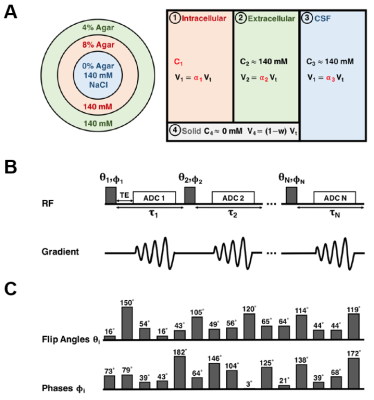 |
85 |
Multi-pulse Sodium Magnetic Resonance Imaging for Multi-compartment Quantification in Brain at 7T
Video Permission Withheld
Martin Gajdošík, Alina Gilles, Ivan Kirov, Guillaume Madelin
We propose a new approach to investigate intra- and extracellular sodium in vivo. In this preliminary study we could differentiate brain compartments and provide an estimate of intracellular and extracellular sodium concentrations as well as intracellular, extracellular and cerebrospinal fluid volume fractions.
|
|
3877.
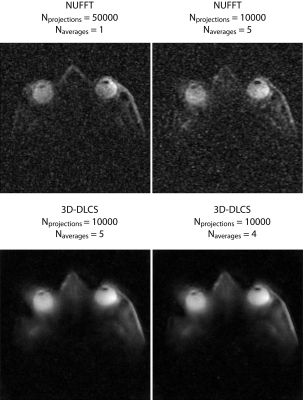 |
86 |
 Application of 3D-Dictionary Learning Compressed Sensing Reconstruction En Route to Isotropic Submillimeter Spatial Resolution Sodium (23Na) In Vivo MRI of the Human Eye at 7.0 Tesla Application of 3D-Dictionary Learning Compressed Sensing Reconstruction En Route to Isotropic Submillimeter Spatial Resolution Sodium (23Na) In Vivo MRI of the Human Eye at 7.0 Tesla
Daniel Wenz, Nicolas Behl, Armin Nagel, Mark Ladd, Thoralf Niendorf
Sodium ion (Na+) is a very important factor in the physiology of the human eye. However sodium (23Na) MRI is limited by its low sensitivity. Compressed sensing provides means to overcome this challenge. This work demonstrates the feasibility of high spatial resolution (1mm isotropic) 23Na in vivo MRI of the eye using a dedicated six-channel transceiver array in conjunction with a 3D dictionary learning compressed sensing algorithm. This approach showed distinct noise reduction along with substantial reduction in total acquisition time if benchmarked against conventional reconstruction employing standard gridding.
|
|
3878.
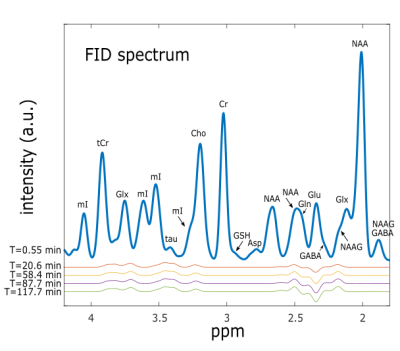 |
87 |
 Simulation of 13C labeling Effects of Glutamate and Glutamine in 1H MR Spectra with different Pulse Sequences at 9.4 T Simulation of 13C labeling Effects of Glutamate and Glutamine in 1H MR Spectra with different Pulse Sequences at 9.4 T
Theresia Ziegs, Anke Henning
Glutamate related metabolism can be measured considering the 13C labeling effects from an administered 13C labeled substrate in pure 1H MRS spectra without a 13C channel. In this work, simulated 1H MRS spectra with FID, semi-Laser, and two PRESS sequences have been compared to optimize spectral resolution for glutamate and glutamine measurements at 9.4 T. Furthermore, spectral changes according to a two-compartment model were analyzed. As a result, this work indicates the fastest possible acquisition can be obtained with an FID sequence, while the best resolution possible can be obtained with a PRESS sequence.
|
 |
3879.
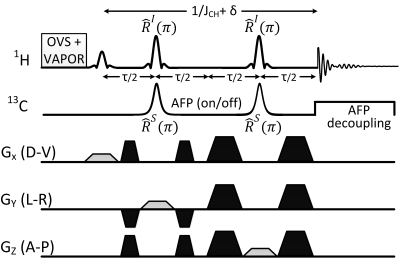 |
88 |
 Minimum echo-time PRESS-localized proton observed carbon edited (POCE) magnetic resonance spectroscopy for rat brain imaging using simultaneous editing and localization pulses. Minimum echo-time PRESS-localized proton observed carbon edited (POCE) magnetic resonance spectroscopy for rat brain imaging using simultaneous editing and localization pulses.
Chathura Kumaragamage, Dan Madularu, Axel Mathieu, Derek Lupinsky, Robin de Graaf, Jamie Near
Dynamic Carbon-13 (13C) magnetic resonance spectroscopy (MRS) remains to be the only noninvasive method capable of measuring neuroenergetics and neurotransmitter cycling in the brain1. Proton observed carbon edited (POCE) MRS2 is an attractive alternative to direct 13C methods due to improved signal-to-noise-ratio (SNR). This study reports a PRESS localized POCE sequence utilizing simultaneous editing and localization (SEAL-PRESS), which allows the TE to be reduced to a theoretically optimal value of ~1/JHC (8.1ms, in this implementation). The sequence was validated in phantom and in a rat preparation, and demonstrated >17% improvement in 13C labeled metabolites relative to a 12.6-ms PRESS-POCE sequence.
|
|
3880.
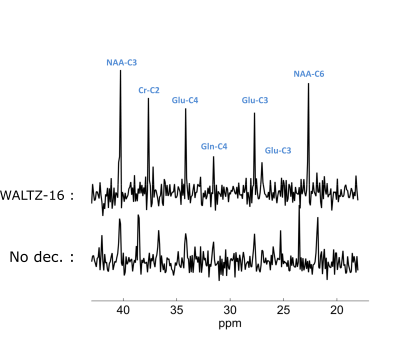 |
89 |
 Evaluation of three different broadband ąH decoupling techniques for 13C-MRS at high field using double-tuned array coils Evaluation of three different broadband ąH decoupling techniques for 13C-MRS at high field using double-tuned array coils
Guillaume Donati, Rolf Gruetter
synopsis
|
|
3881.
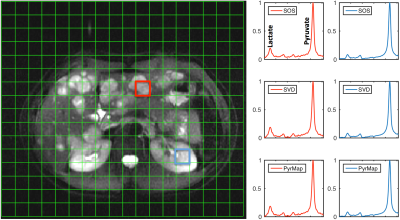 |
90 |
 Coil Combination Methods for 16-channel Hyperpolarized 13C Spectroscopic Imaging Studies of Liver Metastases Patients Coil Combination Methods for 16-channel Hyperpolarized 13C Spectroscopic Imaging Studies of Liver Metastases Patients
Zihan Zhu, Xucheng Zhu, Michael Ohliger, Peng Cao, Shuyu Tang, Jeremy Gordon, Lucas Carvajal, Peter Shin, Rahul Aggarwal, Robert Bok, John Kurhanewicz, Pamela Munster, Peder Larson, Daniel Vigneron
Effective coil combination methods for human hyperpolarized 13C spectroscopy data remain relatively unexplored. This study implemented several coil combination methods, including sum-of-squares (SOS), singular value decomposition (SVD), and pyruvate map based sensitivity calibration (PyrMap). These methods were evaluated by both simulation and in human cancer studies. Overall, both the SVD and PyrMap methods demonstrated better accuracy and robustness than SOS, and the PyrMap best preserved the phase information.
|
|
3882.
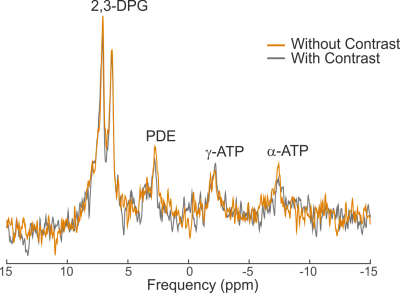 |
91 |
 The effects of iodinated CT contrast agent on phosphorus MRS The effects of iodinated CT contrast agent on phosphorus MRS
Ladislav Valkovic, Justin Lau, Ines Abdesselam, Oliver Rider, Damian Tyler, Christopher Rodgers, Jack Miller
Contrast-enhanced CT examination can influence 1H-MRI measurements performed within 24h after the CT scan, due to a reduction in water T1 and T2 caused by the iodinated contrast agents used in CT. We have investigated whether contrast from a previous CT examination would also influence metabolic measurements made using 31P-MRS, by measuring the T1 of 1H and 31P signals in human blood. We find that iodinated CT contrast agent has no effect on phosphorus T1s. Therefore, 31P-MRS examinations will not be influenced by prior CT (unlike 1H-MRI scans).
|
|
3883.
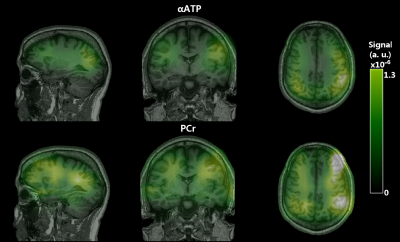 |
92 |
 In vivo 31P MRI at 7 Tesla in humans using a 3D spectrally selective SSFP sequence and TPI k-space sampling. In vivo 31P MRI at 7 Tesla in humans using a 3D spectrally selective SSFP sequence and TPI k-space sampling.
Arthur Coste, Sandro Romanzetti, Denis Le Bihan, Cécile Rabrait-Lerman, Fawzi Boumezbeur
Spectrally selective 31P MRI can be of interest for the study of brain energetics for clinical research. Using a 3D SSFP sequence with non-Cartesian Twisted Projection Imaging sampling, we obtained whole-brain images of ATP and PCr in healthy volunteers at 7 Tesla with a higher normalized SNR than with CSI. Local concentration quantification was performed using the phantom replacement approach after accounting for the T1/T2-weighting and the transmission and reception profiles of our coil yielding consistent results.
|
|
3884.
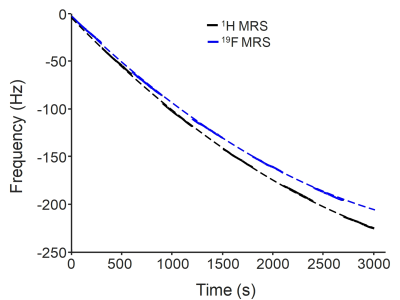 |
93 |
 Retrospective frequency correction for fluorine (19F) MRS using an external reference Retrospective frequency correction for fluorine (19F) MRS using an external reference
Chu-Yu Lee, In-Young Choi, Jean Dinh, William Brooks, Steven Leeder, Phil Lee
Fluorine MR Spectroscopy (19F MRS) allows in vivo quantification of fluorine-containing antipsychotic and antidepressant drug concentrations in the brain. To detect the low concentration of the drugs (~ 5-30 µM) in the brain, it requires multiple repeated acquisitions to increase SNR and the scan time is relatively long. Therefore, it is important to ensure consistent frequency alignment across the repeated acquisitions. However, MR system instability induces drifts of the scanner frequency, particularly following MR scans with a high gradient duty cycle. Previous frequency correction methods for 1H MRS require internal reference signals, such as under- or un-suppressed water, and cannot be applied to 19F MRS, where the SNR of 19F signals is low at each repeated acquisition. The purpose of this study is to investigate the feasibility of using an external reference for retrospective frequency correction in 19F MRS.
|
|
3885.
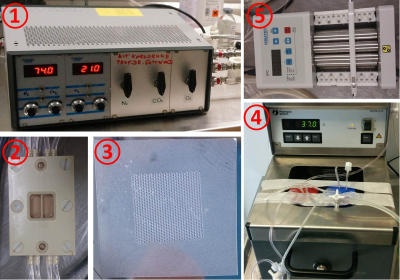 |
94 |
 Measurement of oxygen consumption in a high density 3D cell culture on chip by 19F spectroscopy Measurement of oxygen consumption in a high density 3D cell culture on chip by 19F spectroscopy
Dennis Kleimaier, Michaela Hoesl, Andreas Neubauer, Matthias Malzacher, Cordula Nies, Eric Gottwald, Lothar Schad
Drug-induced mitochondrial dysfunction is of major clinical interest. An NMR-compatible bioreactor system was used to investigate the oxygen consumption of HepG2 cells by measuring T1 of perflubron. The oxygen consumption was measured by stopping the perfusion. This resulted in a reduction of the oxygen concentration from (19.29 ± 0.96)% to (11.41 ± 0.92)% in 104.24 min. Our results might allow for detecting a drug-induced mitochondrial dysfunction of cells in a well-controlled environment by using the two compartments of the bioreactor.
|
|
3886.
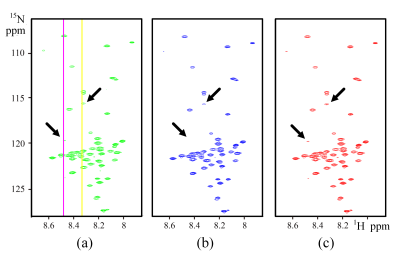 |
95 |
 Low Intensity Spectral Peaks Reconstruction with Weighted Nuclear Norm Minimization on Low Rank Hankel Matrix Low Intensity Spectral Peaks Reconstruction with Weighted Nuclear Norm Minimization on Low Rank Hankel Matrix
Di Guo, Xiaofeng Du, Yu Yang, Meijing Lin, Xiaobo Qu
To speed up the acquisition time of multi-dimensional magnetic resonance spectroscopy (MRS), one typical way is to sparsely acquire free induction decay (FID) data reconstruct the spectrum from the incomplete observations. Recently, a low rank Hankel matrix (LRHM) approach, that explores the sparse number of spectral peaks, has shown great ability to reconstruct the spectrum. When the data are highly undersampled, however, low intensity spectral peaks are compromised in the reconstruction. In this abstract, a weighted LRHM approach is proposed. A weighted nuclear norm is introduced to better approximate the rank constraint, and a prior signal space is estimated from the pre-reconstruction to reduce the number of unknowns in reconstruction. Results on both synthetic and real MRS data demonstrate that the proposed approach can reconstruct low intensity spectral peaks better than the state-of-the-art LRHM method.
|
|
3887.
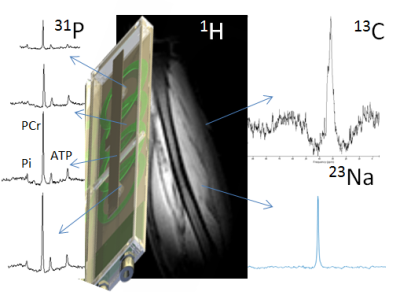 |
96 |
 Quintuple tuned coil configuration for multi-nuclear metabolic MRI at 7 tesla Quintuple tuned coil configuration for multi-nuclear metabolic MRI at 7 tesla
Tijl van der Velden, Anh Pham, Carel van Leeuwen, Debra Rivera, Mark Gosselink, Dennis Klomp
Metabolic and anatomic imaging by combining X-nuclei imaging with 1H imaging has shown great potential in clinical research. Traditional multi-nuclear coil setups are however limited to 2 or 3 frequencies, and often birdcage for 1H. In this study we propose a coil array setup tuned for acquiring 5 different nuclei in a single scan session practically without compromising efficiency on any nuclei.
|
|
MRS Applications
Electronic Poster
Spectroscopy & Non-Proton MR
Tuesday, 19 June 2018
| Exhibition Hall |
08:15 - 09:15 |
| |
|
Computer # |
|
3888.
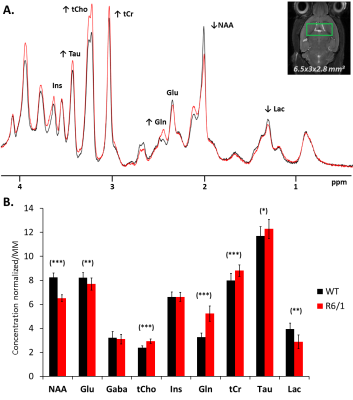 |
97 |
 Probing alterations of cellular metabolism in a mouse model of Huntington’s disease (R6/1) using in vivo MRS and DW-MRS Probing alterations of cellular metabolism in a mouse model of Huntington’s disease (R6/1) using in vivo MRS and DW-MRS
Clémence Ligneul, Edwin Hernandez-Garzon, Marco Palombo, Julien Flament, Julien Valette
Huntington’s disease is a genetic neurodegenerative disorder caused by the abnormal repetition of the CAG triplet in the gene coding for huntingtin (Htt). R6/1 mouse model, expressing a human form of mutated huntingtin, exhibits a progressive neuronal alteration in the striatum. We use in vivo MRS and diffusion-weighted MRS at various diffusion-weightings and diffusion times to detect changes in cellular metabolic content and structure R6/1 mice striatum. We report massive metabolic remodeling, especially for N-acetyl aspartate (NAA) and Glutamine (Gln), as well as changes in glutamate diffusion properties that we tentatively relate to variations in glutamate cellular compartmentation.
|
|
3889.
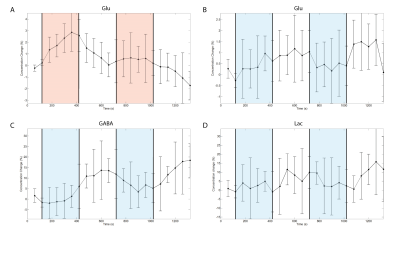 |
98 |
 Metabolite concentration changes associated with positive and negative BOLD signal in the human visual cortex: a functional magnetic resonance spectroscopy study at 7T. Metabolite concentration changes associated with positive and negative BOLD signal in the human visual cortex: a functional magnetic resonance spectroscopy study at 7T.
Yohan Boillat, Lijing Xin, Wietske Van der Zwaag, Rolf Gruetter
The metabolite correlates of the negative BOLD signal were investigated using functional MRS and compared to the changes produced by the positive BOLD response. The participants were scanned in a 7-T MRI while passively viewing visual checkerboards. For the positive BOLD response, increases of glutamate and lactate concentrations were observed, while the negative BOLD response in a similar voxel was linked to a decrease of glutamate, lactate and GABA concentrations. This measured decrease of oxidative metabolism during the negative BOLD response suggest a reduction a glutamatergic activity in the visual cortex.
|
|
3890.
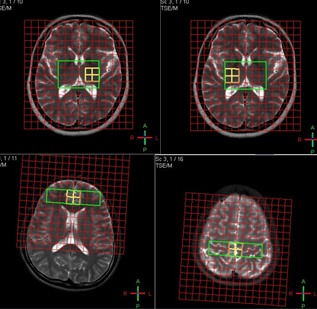 |
99 |
 Changes of brain metabolites in response to acupuncture therapy in migraine are correlated with clinical outcomes: Result from a magnetic resonance spectroscopy imaging Study Changes of brain metabolites in response to acupuncture therapy in migraine are correlated with clinical outcomes: Result from a magnetic resonance spectroscopy imaging Study
Tao Gu, Min Chen, Ryan CN D’Arcy , Xiaowei Song
Migraine is a common neurological disease. Acupuncture has been proven to be effective but the mechanisms remain unclear. A proton magnetic resonance spectroscopy imaging (MRSI) study was used to investigate biochemical changes in brain regions key for the transmission of pain in response to acupuncture treatment. Results showed acupuncture treatment was associated with a significantly increased NAA/Cr in bilateral thalamus in migraine patients. A strong significant correlation between NAA/Cr and headache intensity was found in thalami. Our data provided the first evidence suggesting a brain biochemical change in response to acupuncture therapy in migraine, in correlation with clinical outcomes.
|
|
3891.
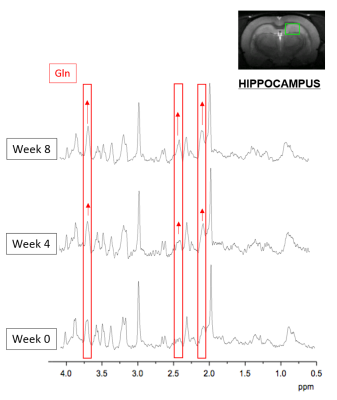 |
100 |
 Synergy between probiotics and antibiotics for the treatment of chronic hepatic encephalopathy: a longitudinal in vivo 1H MRS study of brain metabolism. Synergy between probiotics and antibiotics for the treatment of chronic hepatic encephalopathy: a longitudinal in vivo 1H MRS study of brain metabolism.
Emmanuelle Flatt, Cristina Cudalbu, Olivier Braissant, Stefanita Mitrea, Dario Sessa, Valérie A. Mc Lin, Rolf Gruetter
Chronic hepatic encephalopathy(HE) is a well-accepted complication of chronic liver disease(CLD), and finding the right treatment to reduce HE episodes before liver transplant remains a challenge. Both rifaximin and probiotics are currently used to reduce HE symptoms, but their precise effect on brain metabolites have never been studied. Our aims were first to assess in vivo and longitudinally the effect of the combination of probiotics and rifaximin on a rat model of chronic HE; and second to compare the results obtained to groups of non-treated/rifaximin-only treated rats. 1H-MRS at high field combined with biochemical and behavioral tests were used.
|
|
3892.
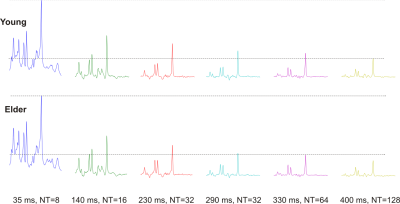 |
101 |
 Shorter apparent T2 relaxation times of metabolites in the older human brain Shorter apparent T2 relaxation times of metabolites in the older human brain
Dinesh Deelchand, J. McCarten, Laura Hemmy, Edward Auerbach, Malgorzata Marjanska
The goal of this study was to compare the apparent transverse relaxation time constants (T2) of metabolites obtained in young and older subjects in three brain regions (occipital cortex (OCC), posterior cingulate cortex (PCC) and prefrontal cortex (PFC)) using LASER at 3T. A lower apparent T2s of N-acetyl aspartate and tissue water were measured in older adults in all three regions. T2 for total creatine and myo-inositol were also shorter in older adults in OCC and PCC. In conclusion, differences in T2 values of metabolites during normal brain aging are region-dependent.
|
|
3893.
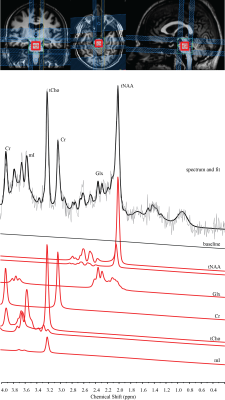 |
102 |
 Magnetic Resonance Spectroscopy biomarkers predict patient outcome in subacute spinal cord injury Magnetic Resonance Spectroscopy biomarkers predict patient outcome in subacute spinal cord injury
Patrik Wyss, Peter Zweers, Anne Brust, Corinne Funk, Markus Berger, Anke Henning
Spinal cord injury (SCI) is a very heterogeneous disease that makes it difficult to identify a single biomarker during rehabilitation therapy in order to predict the future patient status. In this study, we applied Magnetic Resonance Spectroscopy to examine specific metabolic markers in the pons 10 weeks after injury and correlated them with changes of the clinical status obtained twice during early rehabilitation.
|
|
3894.
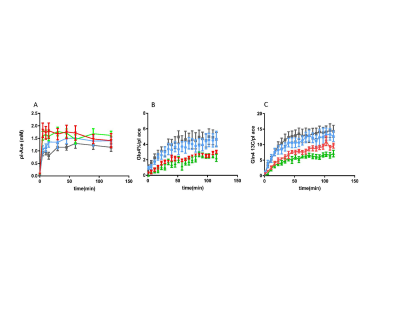 |
103 |
 Partial Normalization of altered brain acetate metabolism in alcohol-dependent subjects after one month of sobriety Partial Normalization of altered brain acetate metabolism in alcohol-dependent subjects after one month of sobriety
Lihong Jiang, Gustavo Angarita, Kevin Behar, Elizabeth Guidone, Barbara Gulanski, Stuart Weinzimer, Robin de Graaf, Graeme Mason
The purpose of this study is to analyze the adaptation of brain acetate metabolism of AD subjects upon detoxification in order to understand the mechanism of alcohol addiction. Using 13C-magnetic resonance spectroscopy in combination of 2-13C-acetate infusion, and monitor the turn over rates of brain 13C-labeled glutamate/glutamine neurotransmitter, we have found increased brain acetate metabolism after detoxification treatment, suggesting the compromised acetate uptake/metabolism in AD subjects.
|
|
3895.
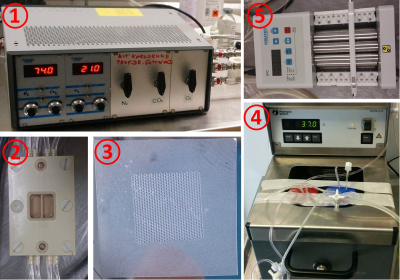 |
104 |
 Investigation of ethanol stimulation on HepG2 cells in a high density cell culture on chip by correlation spectroscopy Investigation of ethanol stimulation on HepG2 cells in a high density cell culture on chip by correlation spectroscopy
Dennis Kleimaier, Andreas Neubauer, Michaela Hoesl, Cordula Nies, Eric Gottwald, Lothar Schad
Ethanol-induced toxicity leads to alterations of certain cellular functions such as mitochondrial dysfunction. This study investigated the feasibility to detect changes induced by 2‰ ethanol stimulation on HepG2 cells in an NMR-compatible bioreactor system by double quantum filtered correlation spectroscopy. During ethanol stimulation, the spectra with cells led to an increased SNR of the glucose (15.5±2.1 %) and lactic acid (10.8%) cross peaks. These changes were larger than the SNR reproducibility of (3.94±2.44)%. Our results show that the DQF-COSY sequence can be used for the investigation of ethanol-induced damage on cells in a bioreactor system (worse shim condition).
|
|
3896.
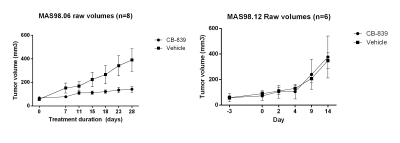 |
105 |
 Response to glutaminase inhibition in patient-derived breast cancer xenograft models Response to glutaminase inhibition in patient-derived breast cancer xenograft models
Maria Grinde, Jana Kim, Ida Henriksen, Hanna Tunset, Siver Moestue
We used ex vivo 13C HR MAS MRS to determine glutamine consumption and conversion in two patient-derived xenograft models of breast cancer, aiming to identify metabolic differences between a responding (luminal-like) xenograft and a resistant (basal-like) xenograft. CB-839 inhibited tumor growth in luminal-like, but not basal-like, xenograft tumors. Response to treatment was associated with differences in glutamine utilization. Depletion of proline in responding tumors indicate that the effect of glutaminase inhibitors may be associated with metabolic adaption to tumor hypoxia.
|
|
3897.
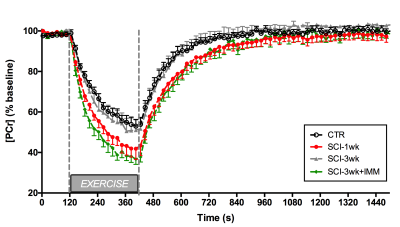 |
106 |
 Energy Metabolism Differences in Rat Skeletal Muscle Due to Restricted Ambulation Following SCI Energy Metabolism Differences in Rat Skeletal Muscle Due to Restricted Ambulation Following SCI
Celine Baligand, Fan Ye, Sean Forbes, Ravneet Vohra, Jonathon Keener, Prodip Bose, Floyd Thompson, Glenn Walter, Krista Vandenborne
Classic rodent models of SCI can rapidly and spontaneously recover locomotor function, muscle mass, and energy metabolism within weeks after injury. This is attributed to “self training” and does not replicate the conditions experienced by human patients who are often confined to bed rest for an extended period of time. Using 31P-MRS during electrically stimulated exercise to assess mitochondrial oxidative capacity in vivo, we show that restricted activity by cast immobilization delays spontaneous recovery of skeletal muscle metabolism in a rat model of severe SCI.
|
|
3898.
 |
107 |
 Noninvasive biomarkers for the early diagnosis and staging of hepatic fibrosis : A real-time in vivo hyperpolarized 13C MR spectroscopy Noninvasive biomarkers for the early diagnosis and staging of hepatic fibrosis : A real-time in vivo hyperpolarized 13C MR spectroscopy
Chung-Man Moon, Yong-Yeon Jeong, Il-Woo Park, Sang-Soo Shin
Hepatic fibrosis associated with chronic liver injury can progress to cirrhosis and ultimately hepatocellular carcinoma. To date, liver biopsy has been regarded as the gold standard for detecting hepatic fibrosis but with practical constraints. Therefore, alternative non-invasive diagnostic methods that can precisely evaluate progression of hepatic fibrosis are urgently needed. However, an in vivo study for hepatic fibrosis using hyperpolarized 13C-labeled pyruvate has not yet been attempted until now. The purpose of this study was to investigate the cellular metabolic changes at different stages of hepatic fibrosis for the early diagnosis.
|
|
3899.
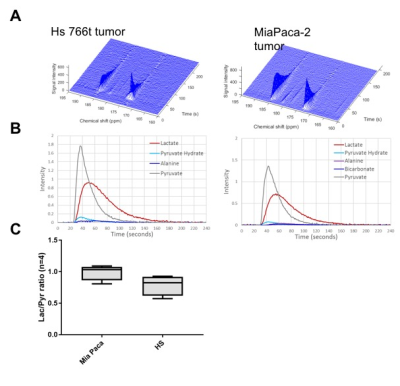 |
108 |
 In vivo characterization of glucose metabolism in pancreatic cancer xenografts. In vivo characterization of glucose metabolism in pancreatic cancer xenografts.
Shun Kishimoto, Jeffrey Brender, Tomohiro Seki, Ayano Enomoto, Kazutoshi Yamamoto, Murali Krishna
Recently, we developed a post processing denoising algorithms that are based on singular value decomposition and its multidimensional analogue Tucker decomposition. These algorithms allow more than 10-fold improvement in signal to noise ratio in dynamic spectroscopy and more than 50-fold in dynamic spectral imaging studies. Using this technique, we successfully characterize the metabolic profiles of two pancreatic ductal adenocarcinoma xenografts, MiaPaca-2 and Hs766t tumors by injecting 50 mg of 13C6 glucose. This imaging is potentially applicable to human subject and provides even more information than PET or 13C DNP MRI alone.
|
|
3900.
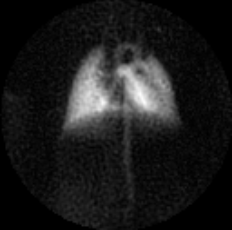 |
109 |
 High-Resolution Cardiopulmonary Imaging in Free-Breathing Mice using Hyperpolarized Xenon-129 High-Resolution Cardiopulmonary Imaging in Free-Breathing Mice using Hyperpolarized Xenon-129
Luis Loza, Mehrdad Pourfathi, Stephen Kadlecek, Kai Ruppert, Hooman Hamedani, Sarmad Siddiqui, Faraz Amzajerdian, Yi Xin, Ryan Baron, Mary Spencer, Tahmina Achekzai, Ian Duncan, Rahim Rizi
Hyperpolarized gas MRI is a well-established tool for assessing lung structure and function in both humans and large animals. However, its utility in small animal models has been limited to terminal studies, as proper gas delivery requires an MR-compatible ventilation scheme that has thus far only been achievable using a terminal intubation process. In this study, we developed a method for delivering hyperpolarized xenon-129 gas to free-breathing mice. An array of pulse sequences were used to acquire high-resolution gas- and dissolved-phase images of the heart and lung structure.
|
|
3901.
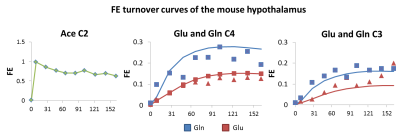 |
110 |
 Feasibility of the in vivo measurement of acetate metabolism by 1H-[13C] MRS at 14.1T in the mouse hypothalamus Feasibility of the in vivo measurement of acetate metabolism by 1H-[13C] MRS at 14.1T in the mouse hypothalamus
Blanca Lizarbe, Irene Guadilla, Rolf Gruetter
Astrocytic metabolism is impaired in many central nervous system diseases, like obesity or diabetes. Using 1H-[13C] MRS together with [2-13C]acetate infusion in a 14.1T magnet, we have measured the incorporation of 13C labeling in the mouse hypothalamus in vivo, and calculated its metabolic fluxes using a two-compartment metabolic model that distinguishes between neurons and astrocytes. We think that these results open the possibility of investigating local variations of astrocytic metabolism in the mouse hypothalamus in vivo.
|
|
3902.
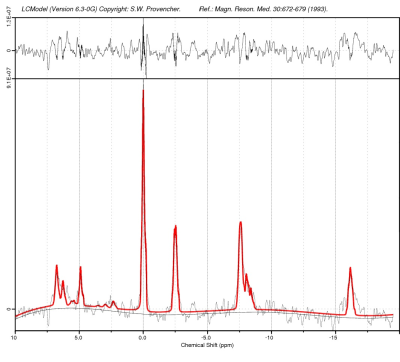 |
111 |
Stress Induced bioenergetic perturbations in CMS rat model of Depression – An invivo phosphorousMRS study at 7T.
Did Not Present
Hemanth Kumar B S, Dinesh Deelchand, Sushanta Mishra, Sadhana Singh, Subash Khushu
A chronic mild stress (CMS) animal model for depression was developed and validated using behavioural studies like OFT, FST and SCT. Following anaesthesia, invivo Phosphorous MRS was acquired covering the entire brain using ISIS pulse sequence at field strength of 7T. The spectra thus acquired were processed using LC-model for bioenergy metabolites quantification. The overall study provides new evidence on brain energy related metabolites and redox balance in CMS rats as compared to controls, suggesting that compromised energy metabolism and altered NAD biology observed in CMS rats. The study also revealed changes in High energy phosphate metabolites and membrane phospholipids.
|
|
3903.
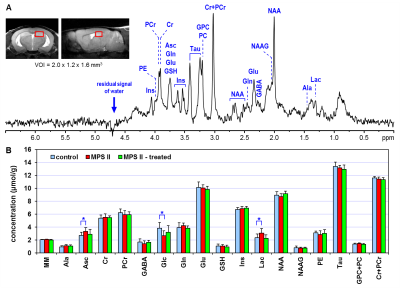 |
112 |
 Assessment of gene therapy efficacy by neurochemical profiling Assessment of gene therapy efficacy by neurochemical profiling
Ivan Tkac, Igor Nastrasil, Kanut Laoharawee, Kelly Podetz-Pedersen, Kelley Kitto, Carolyn Fairbanks, Walter Low, Karen Kozarsky, R McIvor
Mucopolysaccharidosis type II (MPS II), also known as Hunter syndrome, is a rare X-linked recessive lysosomal disorder caused by defective iduronate-2-sulfatase (IDS). Enzyme replacement is the only FDA–approved therapy available for MPS II, but it does not improve neurologic outcomes in MPS II patients. The 1H MRS data acquired from the hippocampus and cerebellum of untreated and AAV9-IDS treated MPS II mice and heterozygote controls clearly demonstrate that the direct transfer of the missing IDS gene to the CNS at 12 weeks of age prevented neurochemical alternations typical for MPS II at 9 months of age.
|
|
3904.
 |
113 |
 Relationship of longitudinal changes in cerebral metabolite and diffusivity property during the early brain development Relationship of longitudinal changes in cerebral metabolite and diffusivity property during the early brain development
Chun-Xia Li, Yuguang Meng, Hui Mao, Anthony Chan, Xiaodong Zhang
In vivo Magnetic Resonance Spectroscopy (MRS) is widely used to characterize the cerebral metabolic disorders in the developing brains of human and animal models. Prior study has demonstrated the spatial and temporal difference in evolution pattern of each metabolite during early brain maturation. This study is aimed to investigate the relationship of the longitudinal change of each metabolite with the microstructural evolution during early brain development in the cingulate cortex (ACC) of rhesus monkeys. The results demonstrated the heterogeneity of correlation degree of each metabolite with the microstructural maturation, suggesting combined MRS/DTI examination could offer complementary information to characterize early brain maturation and related disorders in pediatric research.
|
|
3905.
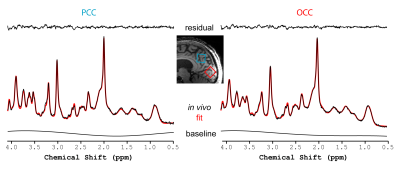 |
114 |
 Higher Vitamin C Concentration in Patients with Alzheimer’s Disease Higher Vitamin C Concentration in Patients with Alzheimer’s Disease
Malgorzata Marjanska, J McCarten, Laura Hemmy, Melissa Terpstra
The concentrations of the antioxidants vitamin C (ascorbate, Asc) and glutathione (GSH) were quantified as components of the neurochemical profile using 7 T 1H MRS in patients with Alzheimer’s disease (AD) and age-matched controls. Spectra were measured at ultra-short echo time in the posterior cingulate cortex (PCC), which is involved in AD, and the occipital cortex (OCC) as a control region. In patients, the concentrations of Asc and myo-inositol were higher in both regions. In the PCC of patients, total choline concentration was also higher.
|
|
3906.
 |
115 |
 Differences in steady-state glutamate levels and variability between ‘non-task-active’ control conditions: Evidence from ąH fMRS of the prefrontal cortex Differences in steady-state glutamate levels and variability between ‘non-task-active’ control conditions: Evidence from ąH fMRS of the prefrontal cortex
Jonathan Lynn, Eric Woodcock, Chaitali Anand, Dalal Khatib, Jeffrey Stanley
Proton functional magnetic resonance spectroscopy (1H fMRS) is capable of detecting dynamic changes in brain glutamate related to task engagement compared to a “non-task-active” control condition. The selection of an appropriate control condition is critical, which may confound the magnitude change in glutamate modulation. The purpose of this 1H fMRS study was to compare the steady-state levels of glutamate and its variability in the left dorsolateral prefrontal cortex during four different putative control conditions. Results show significant differences in the glutamate level and variability between conditions, emphasizing the importance of the control condition for the detection of task-evoked glutamate modulation.
|
|
3907.
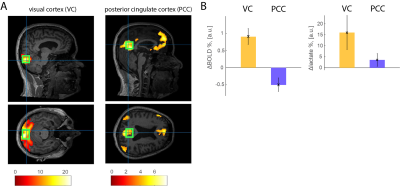 |
116 |
 Metabolic basis of (de)activation fMRI paradigms: J-edited lactate and diffusion-weighted water 1H-MRS Metabolic basis of (de)activation fMRI paradigms: J-edited lactate and diffusion-weighted water 1H-MRS
Yury Koush, Robin de Graaf, Ron Kupers, Laurence Dricot, Douglas Rothman, Fahmeed Hyder
During task-based versus rest epochs, the BOLD signal increases in a task-positive region (activation paradigm) and decreases in a task-negative region (deactivation paradigm), also known as the default mode network (DMN). We investigated the metabolic basis of (de)activation paradigms using concurrent 1H-MRS acquisitions of J-edited lactate and diffusion-weighted water. Using (de)activation paradigms, we detected associated increase of water (i.e., BOLD signal) and lactate in visual cortex (non-DMN area), whereas in posterior cingulate cortex (DMN area) water decreased but lactate did not change. These results suggest similar degrees of aerobic glycolysis in both DMN and non-DMN areas.
|
|
3908.
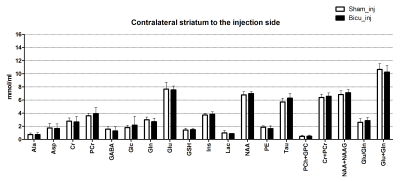 |
117 |
 Neurochemical profiling in the rat model of Tourette’s Syndrome @ 11.7T Neurochemical profiling in the rat model of Tourette’s Syndrome @ 11.7T
Alireza Abaei, Francesca Rizzo, Dinesh K Deelchand, Tobias M. Böckers, Volker Rasche
Tourette’s syndrome (TS) is a neurodevelopmental disorder characterized primarily by motor tics probably due to dysfunctions of the cortico-striato-thalamic-cortical loop (CSTC) but the underlying molecular reason why tic occur is not yet known. In this study, a dedicated optimized STEAM sequence with single-shot phase and frequency correction, and image-based shimming was applied to uncover the metabolic “signature” of a tic using in vivo 1H-MRS at 11.7T. Despite a clear ticking phenotype observed in our animal model, the unaltered striatal neurochemical profile suggest questions on the role of the striatum within the supposed dysfunctional cortical-striatal-thalamic-cortico circuitry in TS.
|
|
3909.
 |
118 |
 Correlations Between Brain Structural Volumes and Brain Metabolite Concentrations in Alzheimer’s Disease: Preliminary Results from the NeuroMet Project Correlations Between Brain Structural Volumes and Brain Metabolite Concentrations in Alzheimer’s Disease: Preliminary Results from the NeuroMet Project
Ariane Fillmer, Theresa Köbe, Semiha Aydin, Laura Goeschel, Agnes Flöel, Florian Schubert, Bernd Ittermann
The NeuroMet project aims to identify new biomarkers for Alzheimer’s disease (AD) and to reduce measurement uncertainties for known biomarkers for AD. This work presents first NeuroMet results with a focus on ultra-high field MR imaging and MR spectroscopy. Significant correlations were found between volumes of cortical and subcortical gray matter structures and concentrations of NAA, glutamate and GABA.
|
|
3910.
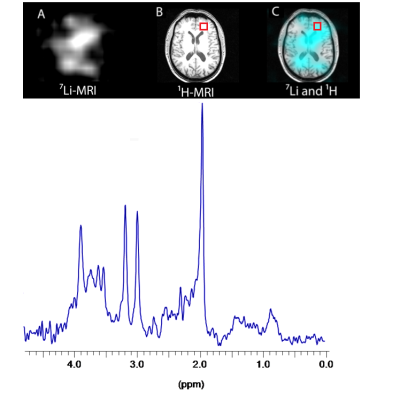 |
119 |
 Brain lithium and myo-inositol levels in lithium treated and non-lithium treated bipolar disorder patients Brain lithium and myo-inositol levels in lithium treated and non-lithium treated bipolar disorder patients
Fiona Smith, Peter Thelwall, Carly Flowers, Matthew Birkbeck, Joe Necus, Andrew Blamire, David Cousins
The action of lithium in bipolar disorder (BD) is incompletely defined but the inositol depletion hypothesis1 states that lithium inhibits IMPase to deplete myo-inositol, confirmed in vivo using proton magnetic resonance spectroscopy (1H-MRS) following acute treatment2,3 Chronic treatment may upregulate IMPase, with trend-level increases in grey matter myo-inositol reported.4 This 1H-MRS study compares frontal white matter myo-inositol/creatine levels (8cm3 voxel) in BD subjects (lithium-treated versus BD controls taking other medication), supplemented by measuring brain lithium signal intensity using 3D 7Li-MRI. Myo-Ino/Cr levels were significantly lower in the lithium-treated group, but their levels did not correlate with 7Li-MRI signal intensity.
|
|
3911.
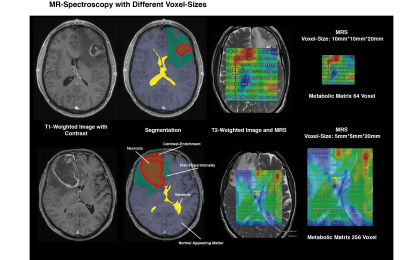 |
120 |
MR-Spectroscopic Imaging in the Spotlight of the 2016 WHO Classification
Did Not Present
Elie Diamandis, Carl Philipp Simon Gabriel, Horst Urbach, Irina Mader, Dieter Heiland
The purpose of this study is to map spatial metabolite differences across the three molecular subgroups of glial tumors, defined by the IDH1/2 mutation and 1p19q-co-deletion, using chemical shift imaging. The classification was based on a radiomic approach to the spectroscopic data.
|
|
J-Difference-Edited MRS/MRSI
Electronic Poster
Spectroscopy & Non-Proton MR
Tuesday, 19 June 2018
| Exhibition Hall |
09:15 - 10:15 |
| |
|
Computer # |
|
3959.
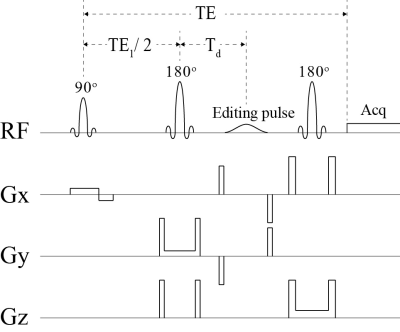 |
49 |
 Simultaneous Measurement of Glutamate, Glutamine, GABA, and Glutathione by Spectral Editing Without Subtraction Simultaneous Measurement of Glutamate, Glutamine, GABA, and Glutathione by Spectral Editing Without Subtraction
Li An, Jun Shen
A novel spectral editing approach was proposed to simultaneously measure glutamate, glutamine, GABA, and glutathione at 7 T. By using a single editing pulse, a relatively short echo time of 56 ms was achieved. The main targets of the signal detection were the H2 and H4 protons of GABA and the H4 protons of glutamate, glutamine, and the glutamyl moiety of glutathione. No motion-sensitive data subtraction was required.
|
|
3960.
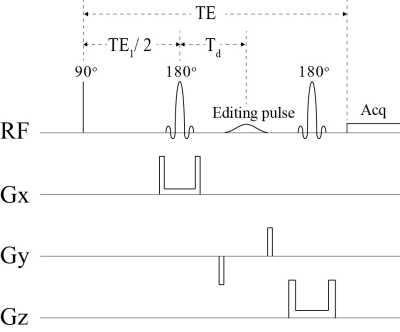 |
50 |
 High-Speed Density Matrix Simulation of PRESS with A Single Editing Pulse High-Speed Density Matrix Simulation of PRESS with A Single Editing Pulse
Li An, Jun Shen
A single spectral editing pulse incorporated into the PRESS sequence produces large Bloch-Siegert shift. The lack of a general method to quantify these shifts for spectral editing experiments has made it necessary to use a second identical editing pulse to cancel the shift. Here we describe a high-speed density matrix simulation method to accurately simulate a PRESS sequence with a single editing pulse for simultaneous detection of glutamate, glutamine, GABA, and glutathione at TE = 56 ms and 7 Tesla. To facilitate in vivo quantification, the frequency dependent Bloch-Siegert shift is accurately calculated and removed from the spectra.
|
|
3961.
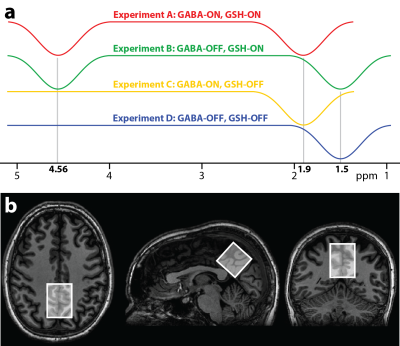 |
51 |
 Simultaneous edited MR spectroscopy of glutathione and macromolecule-suppressed GABA Simultaneous edited MR spectroscopy of glutathione and macromolecule-suppressed GABA
Georg Oeltzschner, Kimberly Chan, Muhammad Saleh, Mark Mikkelsen, Nicolaas Puts, Richard Edden
γ-aminobutyric acid (GABA) and glutathione (GSH) can be simultaneously measured in the human brain in vivo at 3T using Hadamard encoding and reconstruction of MEGA-edited spectroscopy (HERMES). A drawback of conventional HERMES of GABA/GSH is the contamination of the edited GABA peak with co-edited macromolecular signals (MM), reducing the specificity of the method. We propose the addition of symmetrical suppression into the HERMES framework, and demonstrate the successful implementation of this approach in ten healthy subjects.
|
|
3962.
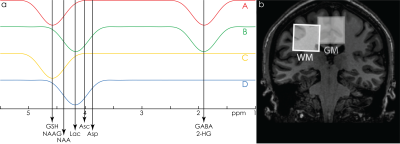 |
52 |
 Editing everything with HERCULES: Hadamard-encoded editing of seven low-concentration metabolites Editing everything with HERCULES: Hadamard-encoded editing of seven low-concentration metabolites
Georg Oeltzschner, Daniel Rimbault, Mark Mikkelsen, Muhammad Saleh, Nicolaas Puts, Richard Edden
Low-concentration metabolites can be detected at 3T with J-difference-edited MR spectroscopy. However, long acquisition times (~10 min per metabolite) make edited studies of many metabolites unfeasible. Multiplexed editing experiments have increased the time efficiency of editing while maintaining its specificity. Here, we introduce HERCULES (Hadamard Editing Resolves Chemicals Using Linear-combination Estimation of Spectra), an advanced multiplexed approach to differentiate the evolution of eight editable spin systems (GABA, GSH, Asp, Asc, NAA, NAAG, Lac and 2-HG) within a single experiment. HERCULES quantifies a total number of 13 metabolites, providing a 7T-like neurochemical profile of neurotransmitters, antioxidants, and metabolic markers at 3T.
|
|
3963.
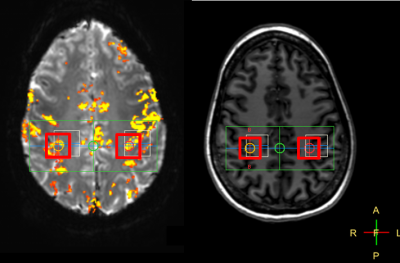 |
53 |
 Bilateral functional MRS of GABA with real-time frequency and motion correction at 7T Bilateral functional MRS of GABA with real-time frequency and motion correction at 7T
Anouk Marsman, Vincent Boer, Mads Andersen, Esben Petersen
Brain function is largely controlled by inhibitory processes steered by main inhibitory neurotransmitter GABA. In this role, GABA is essential in brain development and plasticity as well as neuropsychiatric and neurodegenerative diseases. In order to accurately measure GABA responsiveness, we designed a bilateral edited fMRS sequence including real-time frequency and motion correction, as the relatively weak GABA signal is highly susceptible to frequency drift and motion. As acquisition of the macromolecule-uncontaminated GABA signal is challenging at lower field strengths, experiments were performed at 7T.
|
|
3964.
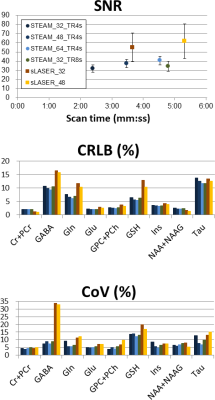 |
54 |
 Test-retest reproducibility of quantitative proton MRS using short-TE STEAM and semi-LASER sequences in young adult volunteer brains at 7T. Test-retest reproducibility of quantitative proton MRS using short-TE STEAM and semi-LASER sequences in young adult volunteer brains at 7T.
Tomohisa Okada, Hideto Kuribayashi, Lana Kaiser, Yuta Urushibata, Nouha Salibi, Ravi Seethamraju, Sinyeob Ahn, Tadashi Isa, Koji Fujimoto
Recently, 7T-MR system has been approved for clinical use in Europe and USA; however, its clinical configuration is limited to single-channel transmit so B1+ shimming is not feasible. This study investigated reproducibility of single-voxel MRS using short-TE STEAM and semi-LASER using a single-transmit & 32-receiver head coil at 7T. Fifteen healthy young volunteers were scanned twice at the posterior cingulate. SNR was higher in semi-LASER, but coefficients of variation were comparable ranging mainly from 5-10% and better in short-TE STEAM in low-concentration J-coupled peaks. Even with clinical setups, 7T shows high reliability and will contribute to MRS investigation.
|
|
3965.
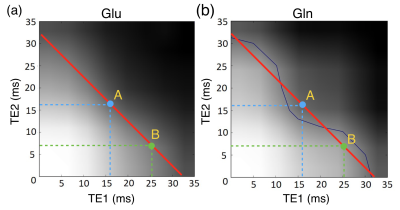 |
55 |
 Impact of sub-echo timings of PRESS on quantitative glutamate/glutamine level using LCModel at 7T Impact of sub-echo timings of PRESS on quantitative glutamate/glutamine level using LCModel at 7T
Tzu-Jung Fei, Cheng-Wen Ko, Moritz Braig, Jochen Leupold
In this study, we investigated the signal variation of Glu and Gln along sub-echo timings (TE1, TE2) in PRESS acquisitions on a preclinical 7T system. Our results show that the choice of sub-echo timings (TE1, TE2) for PRESS may alter the quantitative outcome remarkably for strongly coupled metabolites, e.g. Glu, Gln. The basis-sets used for LCModel analysis has to be carefully simulated and take the sub-echo timings into account since J-evolution of strongly coupled resonances may vary with TE1/TE2 at high fields. Quantitative comparison on these metabolites with mismatched sub-echo timings (TE1, TE2) can result in invalid conclusion.
|
|
3966.
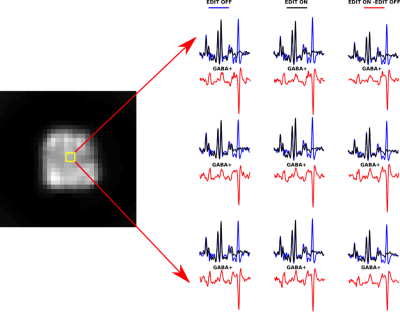 |
56 |
 Non-water Suppressed GABA Edited Magnetic Resonance Spectroscopic Imaging using Density Weighted Concentric Rings k-space Trajectory Non-water Suppressed GABA Edited Magnetic Resonance Spectroscopic Imaging using Density Weighted Concentric Rings k-space Trajectory
Uzay Emir, Pingyu Xia, Xiaopeng Zhou, Mark Chiew, Adam Steel, M Albert Thomas, Ulrike Dydak
In this study, we have developed and demonstrated a non-water suppressed GABA editing Magnetic Resonance Spectroscopic Imaging technique using density-weighted concentric rings k-space trajectory that performs robustly within a clinically feasible acquisition time at 3T. The method has been validated in a series of phantom experiments and its feasibility assessed in a healthy volunteer with a high in-plane resolution of 7.5 × 7.5 mm2. Experiments qualitatively demonstrate the advantage of the proposed method in terms of its improved resolution and reduced contamination of spectra from neighboring voxels.
|
|
3967.
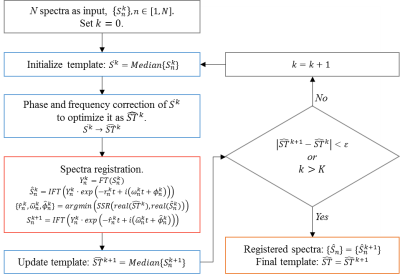 |
57 |
 Automated MR Spectrum Registration for In Vivo Mouse MEGA-PRESS Study at 9.4T And the Introduction of MRSMouse2.0 Automated MR Spectrum Registration for In Vivo Mouse MEGA-PRESS Study at 9.4T And the Introduction of MRSMouse2.0
Jia Guo, Douglas Rothman, Scott Small
The goal of this study was to develop the tailored automated processing and quantification software for Meshcher–Garwood point resolved spectroscopy (MEGA-PRESS) in research of mouse models at 9.4T. The proposed software, MRSMouse, consists of two modules: the data loading module, MRSMouseLoad, which reads the Bruker time-domain raw data and processes it into a frequency-domain GABA-edited spectrum with bandwidth, frequency and phase drift correction through spectrum registration; and the spectral fitting module, MRSMouseFit, which quantifies the metabolite concentrations by modeling the spectra as a linear combination of the simulated basis-set and a smooth-spline in the frequency domain.
|
|
3968.
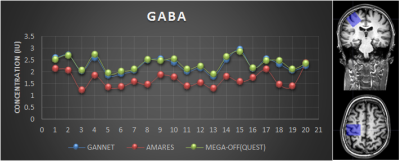 |
58 |
 Comparison of GABA and Glx Quantification from Edited and Unedited MR Spectra – assessment of age effects Comparison of GABA and Glx Quantification from Edited and Unedited MR Spectra – assessment of age effects
Akila Weerasekera, Diana Sima, Ronald Peeters, Tom Dresslaers, Oron Levin, Stephan Swinnen, Sabine Van Huffel, Uwe Himmelreich
1H-MR spectroscopy (MRS) is a well-established tool to provide in vivo measurement of gamma-aminobutyric acid (GABA), glutamine and glutamine (Glx) concentrations for a variety of conditions1. There is an increasing interest in using spectral editing methods to measure GABA and Glx in the human brain. The commonly used GABA-editing sequence MEGA-PRESS provides filtered GABA signals based on the molecule’s J-coupling2, 3. Nonetheless, quantitative comparison among presently used acquisition and analysis methods is lacking. Here we compare currently available spectral fitting methods to assess the in vivo concentration values for GABA and Glx derived from edited (MEGA-PRESS) and unedited (MEGA-PRESS-OFF) spectra. We have tested our approach to assess the inter-subject variability in neurotransmitter levels arising from age effects.
|
|
3969.
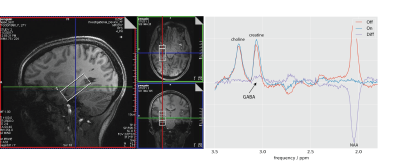 |
59 |
 Towards repeatable GABA-MRS of the hippocampus: Development of an extended post-processing pipeline Towards repeatable GABA-MRS of the hippocampus: Development of an extended post-processing pipeline
Yannik Völzke, Eberhard D. Pracht, Elke Hattingen, Tony Stöcker
The low concentration and the overlap with more prominent resonances hamper the GABA quantification via MR spectroscopy. Strong B0 inhomogeneities in the hippocampus further impede reliable spectroscopic measurements.
To increase the repeatability of the GABA quantification we developed a post-processing module for MEGA-sLASER measurements.The development of an optimized post-processing module reduces the coefficient of variation of the intra-session GABA/creatine signal ratio to (5-10)%. This is essential for clinical trials.
|
|
3970.
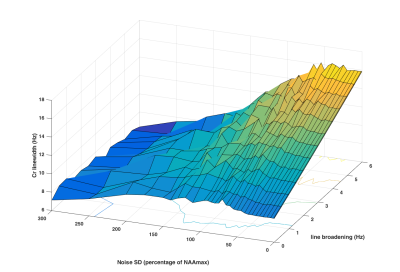 |
60 |
 Simulations of MEGA-PRESS spectra to achieve quality criteria for GABA quantification Simulations of MEGA-PRESS spectra to achieve quality criteria for GABA quantification
Helge Zöllner, Alfons Schnitzler, Hans-Jörg Wittsack
The purpose of this study was to investigate the influence of diminished spectral quality on GABA quantification by using MEGA-PRESS simulations. Different levels of spectral quality were created by adding artificial noise and line broadening to a simulated spectrum to mimic shimming quality. Initial results revealed that the impact of signal to noise ratio (SNR) is much higher than the impact of line broadening. Furthermore the error of peak fitting does not seem to reflect the real quantification error of the known GABA levels of the simulated spectrum. Further simulations and analyses are needed to assure these initial results.
|
|
3971.
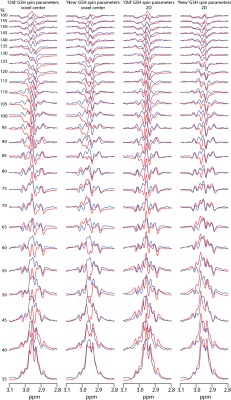 |
61 |
Spectral simulations of glutathione at 7T: Comparison of two different spin system parameter sets
Video Permission Withheld
Muhammad Saleh, Mark Mikkelsen, Georg Oeltzschner, Kimberly Chan, Adam Berrington, Peter Barker, Richard Edden
Glutathione (GSH) is a redox compound, providing protection against reactive oxygen species. Abnormal variation in GSH concentration has been associated with several neurological diseases. Several studies quantify low-concentration metabolites, such as GSH, using simulated basis sets derived from spin system parameters available in the literature. Through simulations and phantom experiments, we assess the accuracy of two different sets of spin system parameters of GSH-cysteine at 7T. The disagreement between the phantom and simulation GSH-cysteine spectra suggests a need for further refinement of the spin system parameters.
|
|
3972.
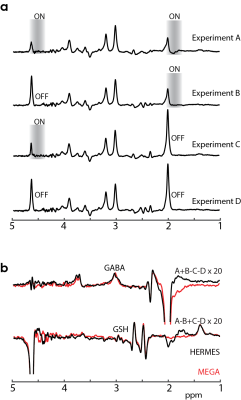 |
62 |
 Simultaneous editing of GABA and glutathione at 7T Simultaneous editing of GABA and glutathione at 7T
Muhammad Saleh, Mark Mikkelsen, Georg Oeltzschner, Kimberly Chan, Adam Berrington, Peter Barker, Richard Edden
HERMES has been shown to simultaneously edit GABA and GSH at 3T. Spectral editing at 7T provides better editing pulse selectivity, e.g. quantifying GABA with less contamination from macromolecules. In this abstract, simulations, phantom and in vivo experiments were performed at 7T using the sLASER sequence for simultaneous editing of GABA and GSH using HERMES. HERMES with sLASER localization at 7T provides uniform localization, doubles the acquisition rate, and provides excellent separation of the metabolites without any loss in spectral quality compared to sequentially acquired measurements of GABA and GSH using MEGA-PRESS.
|
|
3973.
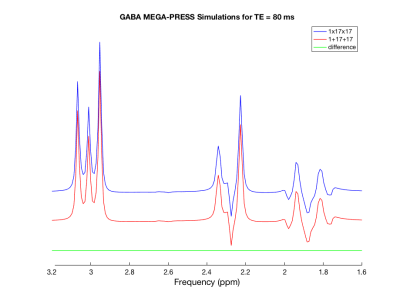 |
63 |
 High Spatial Resolution Simulated Basis Sets for HERMES and MEGA-PRESS High Spatial Resolution Simulated Basis Sets for HERMES and MEGA-PRESS
Diana Rotaru, David Lythgoe
Low concentration metabolites with J-coupled peaks are difficult to quantify using MRS, even using MEGA-PRESS or its recently propose HERMES implementation. Using LCModel with simulated basis sets can lead to inaccurate metabolite quantification, since the spatial-dependence of the signal is often not fully accounted for. This can be minimised by increasing the number of spatial positions simulated, at the expense of computation time. We simulated basis sets for MEGA-PRESS and HERMES using the recently introduced approach based on one-dimension projections, as a replacement for the commonly used three-dimensional method, providing more accurate basis sets in shorter computation time.
|
|
3974.
 |
64 |
 Multi-Step Frequency-and-Phase Correction for Multiplexed Edited MRS Data Multi-Step Frequency-and-Phase Correction for Multiplexed Edited MRS Data
Mark Mikkelsen, Muhammad Saleh, Jamie Near, Kimberly Chan, Tao Gong, Ashley Harris, Georg Oeltzschner, Nicolaas Puts, Kim Cecil, Iain Wilkinson, Richard Edden
Multiplexed edited MRS – more than one edited experiment combined in a single acquisition – involves acquiring subspectra with four or more distinct signal profiles. This technique therefore requires a tailored approach for correcting frequency and phase errors associated with participant head motion and scanner instability. Here, we demonstrate a novel alignment algorithm, termed multi-step frequency-and-phase correction (msFPC), designed to deal with the challenges of aligning individual transients in multiplexed edited data. Testing this method on simulated and in vivo datasets, msFPC was found to outperform other previously demonstrated algorithms (spectral registration and spectral registration with post hoc choline-creatine alignment).
|
|
3975.
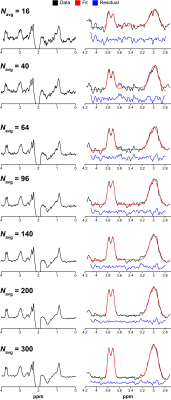 |
65 |
 Scan Duration, Signal-To-Noise Ratio and Sample Size Considerations in GABA-Edited MRS Studies Scan Duration, Signal-To-Noise Ratio and Sample Size Considerations in GABA-Edited MRS Studies
Mark Mikkelsen, Rachelle Loo, Nicolaas Puts, Richard Edden, Ashley Harris
We investigate the relationships between scan duration, signal-to-noise ratio (SNR) and group-level variance in GABA-edited MRS. Typically, GABA editing takes ~10 min for a 27-mL voxel. GABA+/Cr measurements from five voxels from 18 participants were analyzed by cumulatively binning the averages within each dataset to determine the effects on SNR and group-level variance. Sample size calculations estimated the required sample sizes needed for different predicted effect sizes in GABA-edited MRS studies. We show that the duration of GABA-edited acquisitions can be reduced if taking into account a statistically acceptable amount of group-level variance and the magnitudes of predicted effects.
|
|
3976.
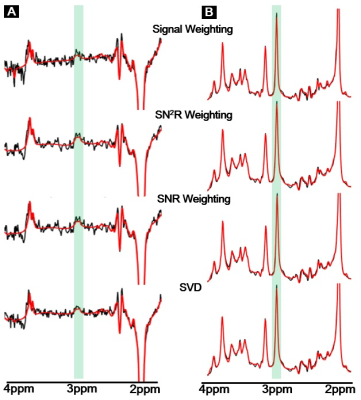 |
66 |
 Optimal phased-array signal combination from separate coil elements for GABA quantification at 7T Optimal phased-array signal combination from separate coil elements for GABA quantification at 7T
Donghyun Hong, Seyedmorteza Rohani Rankouhi, Jan-Willem Thielen, David Norris
Hitherto, signal combination strategies from separate coil elements have been evaluated on the basis of spectral SNR improvement. This study compared various combination methods for two representative GABA measurement techniques: GABA editing and short echo time acquisitions, and investigated which signal combination method is optimal in terms of GABA quantification using LCModel.
|
|
3977.
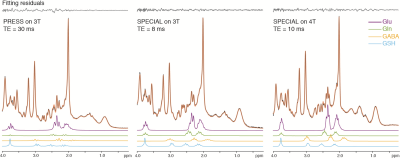 |
67 |
 Feasibility of ultra-short TE MRS with full intensity to detect human brain glutathione, glutamine and GABA on 3 T and 4 T Feasibility of ultra-short TE MRS with full intensity to detect human brain glutathione, glutamine and GABA on 3 T and 4 T
Xi Chen, Yihong Yang, Dost Ongur, Fei Du
GABA, glutamine (Gln) and Glutathione (GSH) are important metabolites in human brain. However, with regular proton MRS, all of them are subject to J modulations during the moderate TE and hardly reliably observed. This study utilizes SPECIAL, an ultra-short TE MRS with full intensity, on 3T and 4T human scanners to test its feasibility to detect GABA, Gln and GSH. Compared to 3T PRESS, SPECIAL on 3T and 4T observed consistent Gln and GSH concentrations with higher reliabilities. Uniquely, 4T SPECIAL observed GABA+MM signal with significantly lower CRLB compared to 3 T measurements.
|
|
3978.
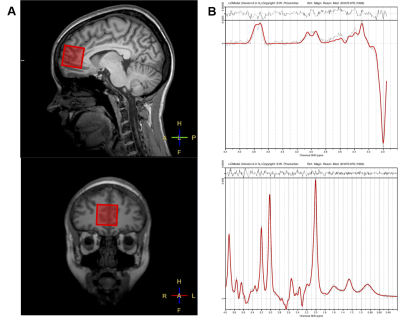 |
68 |
 Increased Rostral Anterior Cingulate Cortex GABA+ Concentrations in IBS Patients with Anxiety Increased Rostral Anterior Cingulate Cortex GABA+ Concentrations in IBS Patients with Anxiety
Sofie Tapper, Adriane Icenhour, Olga Bednarska, Anders Tisell, Susanna Walter, Peter Lundberg
The aim was to investigate whether Glutamate and GABA concentrations were altered in the rACC in patients with IBS compared to healthy controls, and to investigate if the GABA and Glutamate concentrations were associated with the level of anxiety in IBS patients. We observed higher rACC GABA+ concentrations in IBS patients, whereas Glx concentrations remained unaltered. Moreover, the changes in GABA concentrations were most pronounced in patients with high severity of anxiety. Thus, our findings provide first evidence of dysregulated rACC GABAergic neurotransmission in IBS, and suggest that altered inhibitory neurotransmission may be linked to comorbid anxiety in IBS patients.
|
|
3979.
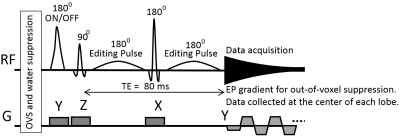 |
69 |
 Macromolecule Suppressed GABA Editing with Reduced Artifact in Region near Sinuses using Improved MEGA-SPECIAL Sequence Macromolecule Suppressed GABA Editing with Reduced Artifact in Region near Sinuses using Improved MEGA-SPECIAL Sequence
Meng Gu, Ralph Hurd, Laima Baltusis, Frederick Chin, Daniel Spielman
B0-inhomogeneity-insensitive GABA editing with MM suppression has been developed using improved MEGA-SPECIAL sequence using highly selective (30 ms) editing pulses allowed by 1D ISIS localization and 1D echo planar gradient in the logical S/I direction. MM suppressed GABA editing was successfully achieved in occipital lobe. However, GABA editing in regions near sinuses, e.g. anterior cingulate cortex (ACC), was compromised from imperfect subtraction in the ISIS localization. To reduce artifact in this region, the ISIS and 1D EP gradient were applied in the logical R/L direction together with a 16-step phase-cycled acquisition. These methods significantly improved edited spectra obtained from ACC.
|
|
3980.
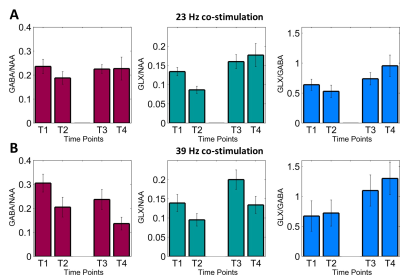 |
70 |
 Frequency-dependent cortical plasticity via GABA modulation Frequency-dependent cortical plasticity via GABA modulation
Caroline Lea-Carnall, Faezeh Sanaei Nezhad, Nelson Trujillo-Barreto, Marcelo Montemurro, Wael El-Deredy, Laura Parkes
Gamma-Aminobutyric acid (GABA) is the major inhibitory neurotransmitter in the human brain and is thought to underlie plasticity processes. We tested the effect of repetitive tactile stimulation using two driving frequencies on GABA concentration using functional magnetic resonance spectroscopy (fMRS) and psychophysics testing. We were able to detect changes within a single scan session at 3 Tesla (3T) and relate these to well-established behavioural markers of plastic change demonstrating the utility of fMRS as a novel tool to understand the mechanisms of plasticity and the efficacy of therapeutic treatments.
|
|
3981.
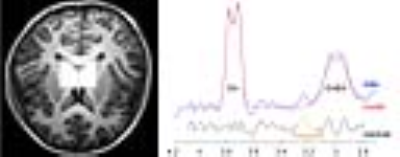 |
71 |
Effect of DRD4 receptor -616 C/G polymorphism on thalamic GABA levels in pediatric primary nocturnal enuresis patients
Did Not Present
Yi You, Zijun Li, Xiaoqi Wang, Bing Yu
The objective of this study is to explore the effect of DRD4 −616 C/G single nucleotide polymorphism (SNP) on thalamic GABA levels in with primary nocturnal enuresis (PNE). Results indicates the DRD4 −616 C allele is associated with increased thalamic GABA levels and higher arousal from sleep (AS) scores in PNE children. This research helps us understand the genetic susceptibility of the DRD4 −616 C allele to PNE.
|
|
3982.
 |
72 |
 Baseline GABA Concentration Predicts Treatment Response to Selective Serotonin Reuptake Inhibitors in Major Depressive Disorder Baseline GABA Concentration Predicts Treatment Response to Selective Serotonin Reuptake Inhibitors in Major Depressive Disorder
Xiang He, Kenneth Wengler, Greg Perlman, Elizabeth Bartlett, Christine DeLorenzo
Major depressive disorder (MDD) affects more than 350 million people world-wide. Large heterogeneities in patient symptoms has led to several different treatment courses. Although treatments, such as SSRIs, are generally effective, a large portion of patients (~30%) do not achieve remission. The ability to predict which treatment option will yield the best outcome would be of great use to clinicians and patients. The GABAergic system is implicated in MDD and affected by SSRIs. In this study GABA concentrations were measured with MEGA-PRESS MRS in MDD patients before and after treatment with a SSRI to determine predictive ability and treatment changes.
|
|
Non-Proton MRS/MRI: Novel Applications
Electronic Poster
Spectroscopy & Non-Proton MR
Tuesday, 19 June 2018
| Exhibition Hall |
09:15 - 10:15 |
| |
|
Computer # |
|
3983.
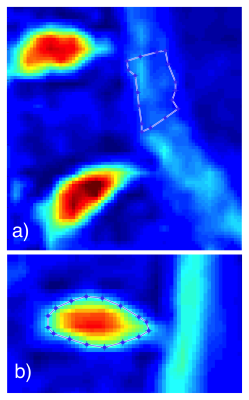 |
73 |
 Relative quantification of the 23Na MRI signal of human intervertebral lumbar discs Relative quantification of the 23Na MRI signal of human intervertebral lumbar discs
Stephan Gruber, Stefan Zbyn, Thomas Stulnig, Wolfgang Bogner, Siegfried Trattnig, Lenka Minarikova
23Na MRI was applied in five healthy volunteers to determine the feasibility of intervertebral discs sodium signal quantification using the cerebrospinal fluid signal from the spinal column as an internal reference. There were no significant differences between the five measured volunteers, or between the different discs (L1/2 – L5/S1), that were analysed. Therefore, internal referencing using CSF has the potential for sodium content quantification in intervertebral discs, which may be used as an indicator of disc degeneration.
|
|
3984.
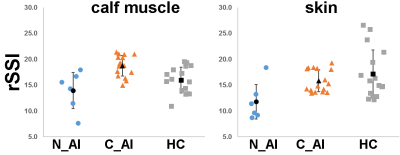 |
74 |
 23NA-MRI of the skeletal muscle and skin in patients with adrenal insufficiency 23NA-MRI of the skeletal muscle and skin in patients with adrenal insufficiency
Andreas Weng, Stephanie Burger-Stritt, Irina-Oana Chifu, Martin Christa, Bernhard Petritsch, Thorsten Bley, Herbert Köstler, Stefanie Hahner
Patients with chronic primary adrenal insufficiency require life-long glucocorticoid- and mineralocorticoid- replacement therapy. Monitoring of treatment is mainly based on clinical parameters and additional measurement of electrolyte status and plasma renin levels. However, obtained values often do not correspond to the patients’ subjective well-being and thus may not fully reflect optimal treatment. The present study investigated sodium content in the calf muscle and the skin obtained via 23Na-MRI in patients with chronic primary AI and healthy controls. Sodium content assessed by 23Na-MRI correlates with further parameters of mineralocorticoid activity and may serve as an objective method to monitor hormone substitution therapy in patients with adrenal insufficiency.
|
|
3985.
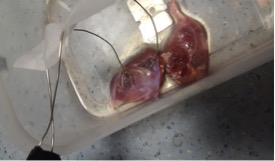 |
75 |
 Electrophysiological stimulation of excised rat muscle elicits a measurable change in tissue sodium concentration using 23Na-MRI Electrophysiological stimulation of excised rat muscle elicits a measurable change in tissue sodium concentration using 23Na-MRI
Frank Riemer, Joshua Kaggie, Cormac O'Neill, Mary McLean, James Grist, Myfanwy Hill, Joe Guy, Rolf Schulte, Martin Graves, James Fraser, Ferdia Gallagher
Changes in the tissue sodium gradient play an important role in cell signalling such as at the neuromuscular junction and as part of neuronal action potentials. 23Na-MRI has the ability to measure the macroscopic sodium distribution. In this study we investigated the changes in tissue sodium in an electrically stimulated and freshly excised rat leg muscle.
|
|
3986.
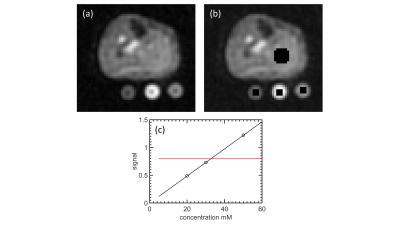 |
76 |
 Comparison of quantitative imaging methods of sodium concentration in leg muscle Comparison of quantitative imaging methods of sodium concentration in leg muscle
Ryan Larsen, Luis Perez, Kenneth Wilund, Theodore Claiborne, Brad Sutton
Quantitative imaging of tissue sodium content requires corrections for coil loading. This can be done by introducing external calibration standards within the scan, or by employing the principle of reciprocity to normalize the signal by the voltage required to obtain a signal maximum. A direct comparison of these two quantification methods shows that they are highly consistent.
|
|
3987.
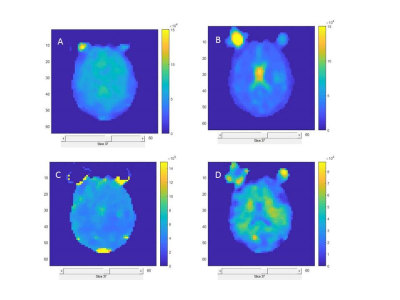 |
77 |
 Mapping Brain Tissue Sodium Parameters Using Fast 3D Multi-Echo Radial Imaging Mapping Brain Tissue Sodium Parameters Using Fast 3D Multi-Echo Radial Imaging
Jinhu Xiong, William Kearney, Ankit Parekh, Mathews Jacobs, Rolf Schulte, Baolian Yang, Vincent Magnotta
We have developed 3D Multi-Echo Radial Imaging and Tikhonov reconstruction techniques for mapping brain tissue sodium concentration and R2* relaxation rate. The total acquisition time is about 6 minutes. Intra- and inter-cellular sodium concentrations and R2* relaxation rates were simultaneous estimated. Our long term aim is to develop 23Na imaging techniques for studies of brain function and diseases.
|
|
3988.
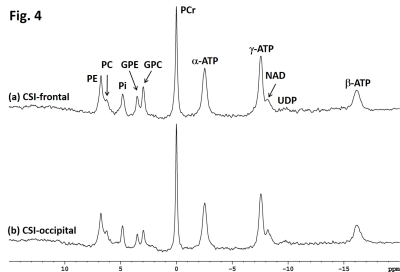 |
78 |
 31P MRS of the frontal lobe of human brain at 7T 31P MRS of the frontal lobe of human brain at 7T
Shizhe Li, Li An, Jan Willem van der Veen, Maria Ferraris Araneta, Johnson Christopher, Yu Shao, Shumin Wang, Jun Shen, Jun Shen
The majority of neuropsychiatric disorders are thought to be originated in the frontal lobe. Increasing the SNR of frontal lobe 31P MRS using a surface coil can be very important because many MRS manifestations of psychiatric illnesses could be subtle. This study demonstrates the feasibility of high SNR 31P MRS of human frontal lobe using a surface coil and 3D CSI at 7 Tesla. Comparing to the occipital lobe spectra acquired from the same subject it was shown that the sensitivity and spectral resolution of 31P MRS spectra of the frontal lobe can be made comparable to that of the occipital lobe.
|
|
3989.
 |
79 |
 Influence of BMI and hepatic lipids on absolute quantification of 31P metabolites at 7T Influence of BMI and hepatic lipids on absolute quantification of 31P metabolites at 7T
Lorenz Pfleger, Martin Gajdošík, Peter Wolf, Sabina Smajiš, Paul Fellinger, Sigfried Trattnig, Michael Krebs, Marek Chmelík, Martin Krššák
This study focuses on absolute quantification of hepatic 31P metabolites at ultra-high field (7T) and the possible influence of BMI and hepatocellular content of lipids (HCL) on the calculated metabolite concentrations. Significant differences were found in γ- and α-ATP as well as in Pi content for population groups with normal and high BMI. With the assessment of HCL it is possible to correct for those differences and no significances could be reported after.
|
|
3990.
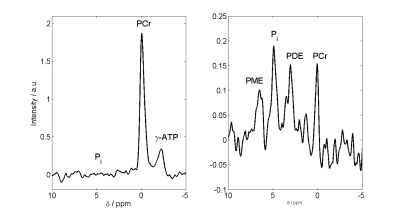 |
80 |
 Unambiguous detection of cardiac Pi using long TM 31P STEAM Unambiguous detection of cardiac Pi using long TM 31P STEAM
Albrecht Schmid, Ladislav Valkovic, Elizabeth Tunnicliffe, Christopher Rodgers
Inorganic Phosphate is a resonance that holds important information on the metabolic state of tissues. From its resonance frequency, intracellular pH can be derived. The ratio of Pi to PCr or ATP are also important markers. Unlike in other tissues, myocardial Pi is frequently hidden underneath blood 2,3-DPG signals. Using 7 T STEAM's TM delay to be one cardiac cycle, blood-pool originating signals are gone and the Pi resonance is clearly visible. In 3 subjects, Pi signal was detected and quantified. The signal was around 4.89±0.02ppm, corresponding to a pH of 7.08±0.02. This is a breakthrough for the investigation of cardiac metabolism.
|
|
3991.
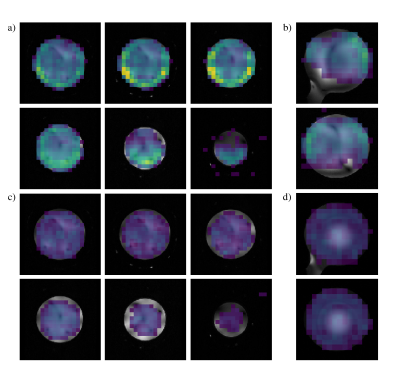 |
81 |
 First experiences with a phosphorus 30 channel receiver head array at 7T First experiences with a phosphorus 30 channel receiver head array at 7T
Benjamin Rowland, Ian Driver, Mohamed Tachrount, Dennis Klomp, Ria Forner, Anh Pham, Michel Italiaander, Richard Wise
Multi-receiver arrays offer the high sensitivity of surface coils and the extended field of view of volume coils, as long as the individual receivers can be combined correctly. In 31P MRS, the low intrinsic SNR makes determining weighting factors challenging and data quality can suffer. We report on our experiences of working with a custom-built 30 channel head coil, dual-tuned for 1H and 31P at 7T, comparing its performance against a traditional birdcage, in phantom and in vivo. Our results are encouraging, with equal SNR in the centre of the brain and significantly enhanced signal in the periphery.
|
|
3992.
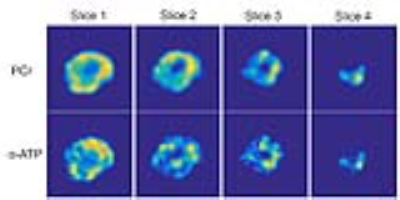 |
82 |
 In vivo Phosphorus Metabolite Imaging on a 3T MRI Scanner in a Clinically Feasible Scan Time In vivo Phosphorus Metabolite Imaging on a 3T MRI Scanner in a Clinically Feasible Scan Time
Yunhong Shu, Joshua Trzasko, Aiming Lu, Joel Felmlee, John Port
We developed an MRI system (coil, sequence, reconstruction) capable of performing imaging of phosphorus metabolites in a clinically-feasible scan time on a conventional 3T MRI scanner. Each component of the system is explained, and results of a phantom scan and scan of a human thigh are presented.
|
|
3993.
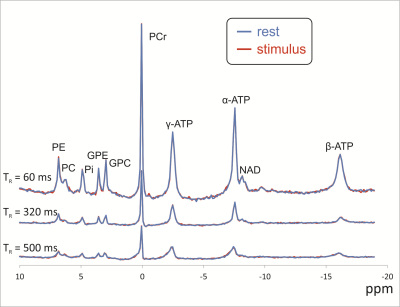 |
83 |
 Functional phosphorus spectroscopy of the human visual cortex at 9.4 T Functional phosphorus spectroscopy of the human visual cortex at 9.4 T
Rolf Pohmann, Sathiya Raju, Klaus Scheffler
Functional 31P spectroscopy has been investigated in several studies with greatly varying results, which may be due to the low sensitivity of the 31P nucleus. We have taken advantage of the high SNR at 9.4 T to acquire spectra from the human visual cortex under stimulation. Experiments were performed with different localization volumes, defined by saturation pulses. In spite of the excellent quality of the obtained data, no stimulation-related changes in metabolite concentrations or resonance frequencies could be detected.
|
|
3994.
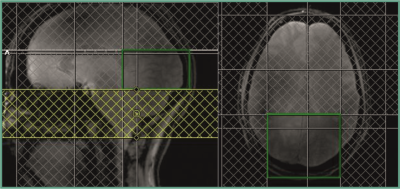 |
84 |
 T1 values of phosphorus metabolites in the human visual cortex at 9.4 T T1 values of phosphorus metabolites in the human visual cortex at 9.4 T
Rolf Pohmann, Sathiya Raju, Klaus Scheffler
Ultra-high field has the potential to improve the quality of 31P spectroscopic applications due to the increased SNR and spectral dispersion. In addition, previous studies have reported a decreasing T1 with increasing field strength, which would further contribute to an improved quantification quality. In this study, we have measured the longitudinal relaxation time T1 in the visual cortex of healthy human subjects at 9.4 T, using an inversion-recovery technique. The values obtained were consistently lower than published data at 7 T, confirming observations of a decreasing T1 with field strength.
|
|
3995.
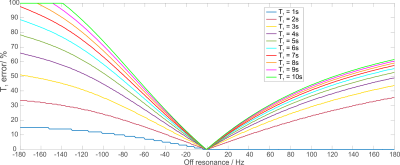 |
85 |
 Quantification of human cardiac inorganic phosphate content in vivo by 31P-MRSI at 7T Quantification of human cardiac inorganic phosphate content in vivo by 31P-MRSI at 7T
Ladislav Valkovic, Albrecht Schmid, Lucian Purvis, Jane Ellis, Matthew Robson, Stefan Neubauer, Christopher Rodgers
Determination of human cardiac Pi using 31P-MRS is challenging as the resonance frequency of Pi is concealed by a close resonating 2,3-DPG signal originating from blood. Long TR acquisition using adiabatic excitation at 7T can compensate for the rapid blood signal replacement in partially-saturated short TR scans. In order to quantify Pi concentration in vivo, knowledge about longitudinal relaxation of Pi is still required. We have measured the T1 of Pi in 4 healthy volunteers at 7T using dual-TR method and used this value to quantify cardiac Pi concentration in 8 healthy volunteers.
|
|
3996.
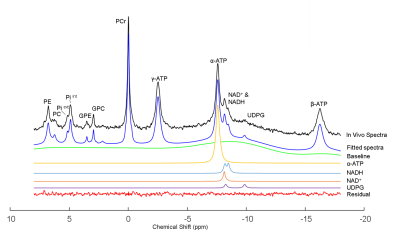 |
86 |
 In Vivo Measurement of Cerebral NAD Contends and Redox State in Young Mouse. In Vivo Measurement of Cerebral NAD Contends and Redox State in Young Mouse.
Radek Skupienski, Kim Do, Roger Marti, Lijing Xin
Nicotimamide adenine dinucleotide (NAD+ and NADH) is a key player of cell energy metabolism. 31P-MRS has been demonstrated for in vivo measurement of NAD content and redox state in cat and human brain, however, there is no reports in mouse brain. In this study we established the in vivo measurement of NAD+, NADH and NAD+/NADH in young (prepubetrtal) mice and compared two different quantification methods (Least square fitting and LCmodel). This study demonstrated the feasibility of in vivo measurement of NAD+, NADH and redox state in mouse brain and it opens the prospect of studying longitudinally the energy metabolism and redox dysfunction in mouse models of brain pathologies.
|
|
3997.
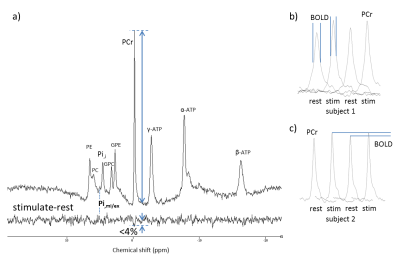 |
87 |
 SNR optimized $$$^{31}$$$P fMRS to measure energy metabolism in the visual cortex SNR optimized $$$^{31}$$$P fMRS to measure energy metabolism in the visual cortex
Arjan Hendriks, Wybe van der Kemp, Natalia Petridou, Dennis Klomp
Energy metabolism of the human visual cortex was investigated, by performing 31P fMRS. The used setup was optimized for high SNR by using a dedicated 31P RF coil at 7T and a visual stimulus with a large visual angle. Changes in the up-field peak of inorganic phosphate (Pi) are observed, revealing new promising opportunities to measure energy metabolism in the human visual cortex.
|
|
3998.
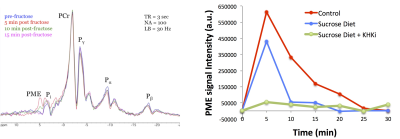 |
88 |
 Dietary modulation of metabolic enzyme activity assessed by dynamic in vivo 31P-MRS of hepatic fructose metabolism Dietary modulation of metabolic enzyme activity assessed by dynamic in vivo 31P-MRS of hepatic fructose metabolism
Christian Farrar, Gregory Tesz, Jeremy Wellen
In this study, 31P-MRS was applied to monitor hepatic fructose metabolism of rats in response to IV fructose challenge. Animals exposed to 7-days of sucrose-enriched diet experienced enhanced fructose clearance relative to animals on an isocaloric control diet. The finding of more efficient fructose metabolism in the sucrose fed group corresponded with elevated KHK and AldoB gene expression, two key enzymes responsible for fructose clearance. Treatment of animals on sucrose diet with a KHK inhibitor nearly completely blocked fructose metabolism and prevented increased expression of these enzymes, implying that metabolism of fructose elicits the enzyme induction rather than fructose itself.
|
|
3999.
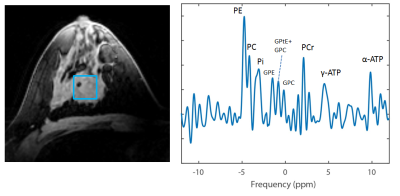 |
89 |
 In vivo $$$^{31}\hspace{0.1 mm}$$$P-MRS of triple negative breast cancer patients In vivo $$$^{31}\hspace{0.1 mm}$$$P-MRS of triple negative breast cancer patients
Erwin Krikken, Wybe van der Kemp, Peter Luijten, Kenneth Gilhuijs, Dennis Klomp, Hanneke van Laarhoven, Jannie Wijnen
31P-MR spectra of breast cancer tissue have shown very high GPC/PC ratios in xenografts for triple negative (TN) tumors. We set out to investigate if this is also visible in vivo in six TN breast cancer patients. In two of the patients the phosphocholine (PC) peak is missing or approaching zero. To the best of our knowledge, this is the first time that this phenomenon is shown in vivo in breast cancer patients, however, the relation of the presence or absence of PC and TN subtype remains to be investigated.
|
|
4000.
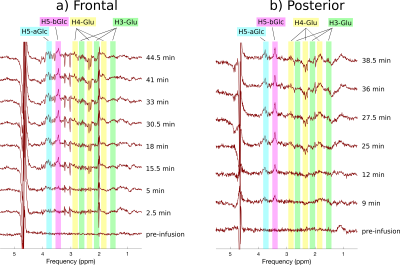 |
90 |
 Detection of 13C glucose metabolism in multiple human brain regions using dynamic 1H MRS Detection of 13C glucose metabolism in multiple human brain regions using dynamic 1H MRS
Steven Zhang, Chathura Kumaragamage, Pedro Neto, Jamie Near
In vivo carbon-13 magnetic resonance spectroscopy is a quantitative technique for studying brain metabolism. Here, we demonstrate the use of 1H MRS to indirectly observe the metabolism of 13C labelled glucose, simultaneously in two brain regions in a single healthy volunteer. This was done using only standard proton (1H) MRS sequences and hardware. Our results demonstrate an accumulation of 13C label in glutamate and glutamine that is distinctly observable due to the pronounced effect of heteronuclear scalar coupling. This technique provides insight into neuronal metabolic rates and may provide complimentary information to 18F-FDG PET in the study of neurodegenerative disorders.
|
|
4001.
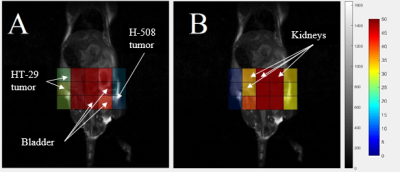 |
91 |
 Detection of 5-Fluorouracil (5-FU) Tumor Trapping Using Fluorine-19 Chemical Shift Imaging in a Murine Model of Colorectal Cancer Detection of 5-Fluorouracil (5-FU) Tumor Trapping Using Fluorine-19 Chemical Shift Imaging in a Murine Model of Colorectal Cancer
Yurii Shepelytskyi, Karen Davenport, Matthew Fox, Tao Li, Mitchell Albert, Eric Davenport
Colorectal cancer is an increasing healthcare problem and is the third leading cause of cancer deaths worldwide. Fluorine-19 (19F) chemical shift imaging (CSI) can detect the distribution of 5-fluorouracil (5-FU) and its metabolites within a tumor over time. By measuring the 5-FU trapping, it is possible to determine the tumor response at the earliest stage of treatment (before changes in tumor size are observable). In this work, we present preliminary results of detecting the presence and absence of 5-FU trapping in mice bearing H-508 and HT-29 colorectal tumors, respectively.
|
|
4002.
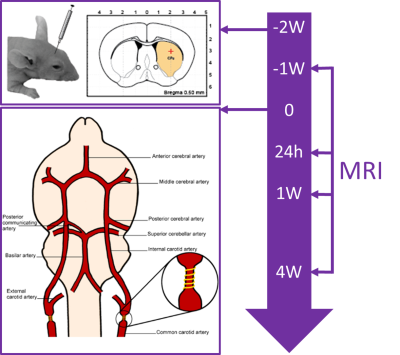 |
92 |
 Mapping longitudinal changes in brain oxygenation in vascular cognitive impairment using 19F-MRI Mapping longitudinal changes in brain oxygenation in vascular cognitive impairment using 19F-MRI
Ahmed Khalil, Susanne Mueller, Marco Foddis, Janet Lips, Ulrich Dirnagl, Sebastian Temme, Ulrich Floegel, Philipp Boehm-Sturm
We assessed tissue oxygenation with 19F-MRI using perfluorocarbon emulsions in a mouse model of vascular cognitive impairment. Brain T1 values were measured using a cryogenic 19F/1H coil at multiple timepoints before and after surgery to induce bilateral common carotid artery stenosis and converted to pO2. T1 values decreased with increasing concentration of inhaled oxygen, and we observed a decrease in tissue pO2 following surgery which gradually recovered over four weeks. 19F-MRI of perfluorocarbon emulsions can be used for long-term assessment of brain tissue pO2 in vivo and may be relevant for monitoring endogenous or induced regenerative processes.
|
|
4003.
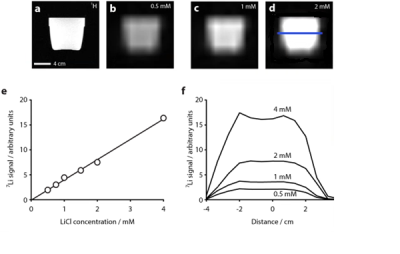 |
93 |
 3D 7Li Magnetic Resonance Imaging of Brain Lithium Distribution in Bipolar Disorder 3D 7Li Magnetic Resonance Imaging of Brain Lithium Distribution in Bipolar Disorder
Fiona Smith, Peter Thelwall, Carly Flowers, Joe Necus, Andrew Blamire, David Cousins
Lithium is a major treatment for bipolar disorder (BD) and the likelihood of a favourable response may be determined by its distribution in the brain. Lithium can be directly detected by magnetic resonance (MR), but this is challenging compared to proton MRI due to lithium’s low therapeutic concentration in brain (<1mM). To overcome this challenge, we implemented a highly efficient balanced steady state free precession (b-SSFP) 7Li-MRI method. We report a 3D 7Li-MRI acquisition with 25mm isotropic resolution, acquired in 8 minutes using a 3T clinical scanner, demonstrating heterogeneity in lithium concentration within the brain in subjects with BD (n=14).
|
|
4004.
 |
94 |
 Use of dissolved-phase 129Xe imaging to visualize gas uptake and distribution in the free-breathing mouse Use of dissolved-phase 129Xe imaging to visualize gas uptake and distribution in the free-breathing mouse
Luis Loza, Stephen Kadlecek, Mehrdad Pourfathi, Kai Ruppert, Hooman Hamedani, Ian Duncan, Rahim Rizi
The lung is an intrinsically difficult organ to image using conventional MRI. Although global structural features and major abnormalities are detectable using conventional MRI, lung structure on the vascular level is prohibitively difficult to image. Hyperpolarized gas MRI provides high enough signal to obtain high-resolution images of lung structure at the acinar level. Furthermore, with the use of hyperpolarized xenon MRI, dynamic images of xenon dissolution are made obtainable given xenon’s high solubility in blood and tissue. By applying decreasingly destructive pulses, the uptake and distribution of the gas throughout the body becomes visible.
|
|
4005.
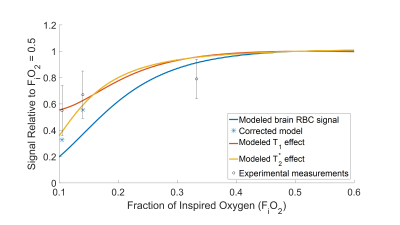 |
95 |
 Effects of Fraction of Inhaled Oxygen on Hyperpolarized 129Xe MR Signals Acquired from the Rat Brain In Vivo Effects of Fraction of Inhaled Oxygen on Hyperpolarized 129Xe MR Signals Acquired from the Rat Brain In Vivo
Yonni Friedlander, Marcus Couch, Andrea Kassner, Giles Santyr
A theoretical model was developed to describe the dependence of the signal strength of 129Xe dissolved in the rat brain on the fraction of inhaled oxygen (FiO2). To validate the model, 129Xe MR signals were measured in the rat brain in vivo for four different values of FiO2 using a continuous ventilation scheme. The measured 129Xe RBC signal showed a strong dependence on FiO2 in good agreement with the trends predicted by the theoretical model. These results underscore the need to optimize and control FiO2 when using 129Xe signals to probe brain function.
|
|
4006.
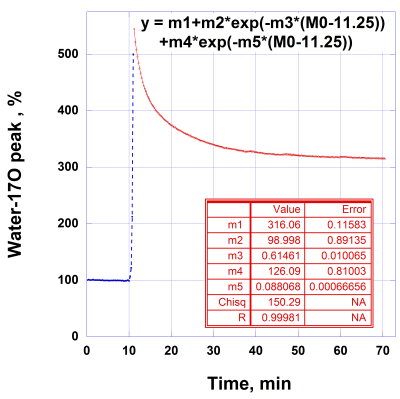 |
96 |
 17O bolus fluxes in rat head at 21.1 T 17O bolus fluxes in rat head at 21.1 T
Victor Schepkin, Cathy Levenson, Andreas Newbauer, Christian Schuch, Tilo Glaeser, Michael Kievel, Steven Ranner, William Brey, Shannon Helsper, Lothar Schad
17O MRI is an attractive and promising goal utilizing ultra-high magnetic fields. The current study is devoted to the time changes of 17O MR signals detectable in a rat head at 21.1 T using bolus injection of 17O labeled water-17O and glucose-17O. The time course of 17O-water revealed a two stage process of distribution. During glucose injection the time course has the same stages as for water, and the third stage represents glucose metabolism. The shape of the high resolution glucose time course is important for the accurate determination of tissue glucose consumption.
|
|
Spectroscopy: NMR & Other
Electronic Poster
Spectroscopy & Non-Proton MR
Tuesday, 19 June 2018
| Exhibition Hall |
09:15 - 10:15 |
| |
|
Computer # |
|
4007.
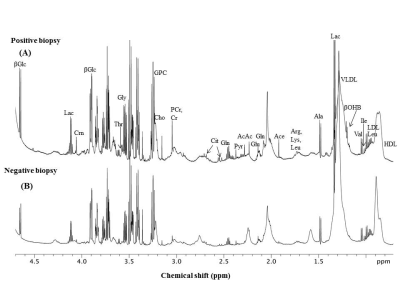 |
97 |
 Metabolic Profiling of Blood Plasma for Distinguishing Prostate Cancer in Patients with Positive Biopsy and Negative Biopsy using NMR Spectroscopy Metabolic Profiling of Blood Plasma for Distinguishing Prostate Cancer in Patients with Positive Biopsy and Negative Biopsy using NMR Spectroscopy
Naranamangalam Jagannathan, Pradeep Kumar, Rajeev Kumar, Virendra Kumar, Senthil Kumaran, Sanjay Thulkar, Sanajy Sharma, Siddhartha Gupta
The metabolic profiling of blood plasma sample for distinguishing prostate cancer (PCa) patients with positive biopsy (n=32) and negative biopsy (n=30) using NMR spectroscopy was investigated. A significantly higher concentration of lactate, choline, glucose and a lower concentration of histidine, tyrosine and phenylalanine were observed in blood plasma of PCa patients with positive biopsy as compared to negative biopsy. Our results suggest alterations in amino acid, energy, glucose and choline metabolisms, which may have association with disease progression.
|
|
4008.
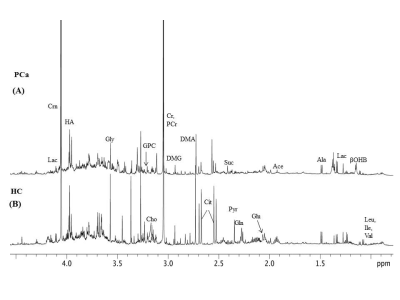 |
98 |
 Study of Altered Urinary Metabolism in Prostate Cancer Patients using NMR Metabolomics Study of Altered Urinary Metabolism in Prostate Cancer Patients using NMR Metabolomics
Pradeep Kumar, Rajeev Kumar, Virendra Kumar, Senthil Kumaran, Sanjay Thulkar, Siddhartha Gupta, Naranamangalam Jagannathan
The present study demonstrated the metabolic profile of urine samples of prostate cancer (PCa) patients (n=33) and healthy controls (HC; n=21) using 700 MHz high-resolution proton NMR for early diagnosis and to define noninvasive biomarker/s. A significantly lower concentration of leucine, histidine, tyrosine, citrate, dimethylglycine, glycerophosphocholine, choline, creatinine, indoxyl sulphate and formate was seen in PCa patients. These findings suggest metabolic alterations due to mitochondrial dysfunction, cell proliferation, energy demand, oxidative stress and protein turnover in PCa patients.
|
|
4009.
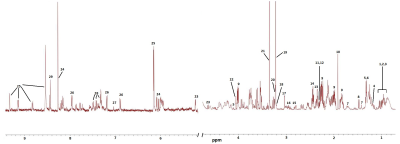 |
99 |
 Magnetic resonance spectroscopy-based metabolic biomarkers of IDH1 mutant glioma in response to temozolomide therapy Magnetic resonance spectroscopy-based metabolic biomarkers of IDH1 mutant glioma in response to temozolomide therapy
Elavarasan Subramani, Lydia Le Page, Russell Pieper, Sabrina Ronen
The alkylating agent temozolomide (TMZ), previously used only in the treatment of high-grade glioblastoma, is now being considered for the treatment of low-grade glioma that are driven by mutations in the cytosolic isocitrate dehydrogenase 1 (IDH1) gene. However, early detection of response remains a challenge. 1H magnetic resonance spectroscopy-based metabolic profiling of cells genetically engineered to express mutant IDH1 and treated with TMZ showed significant alterations in metabolites majorly related to the tricarboxylic acid cycle, pyruvate metabolism and the pentose phosphate pathway. These findings hold potential for assessing response of IDH1 mutant cells to TMZ therapy.
|
|
4010.
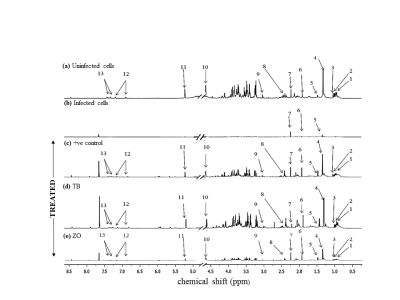 |
100 |
In vitro screening of drug response in HIV-1 pseudovirus infected cells using NMR
Video Permission Withheld
Aruna Singh, Muzamil Makhdoomi, Kalpana Luthra, Thirumurthy Velpandian, Rama Jayasundar
There is a necessity for novel and quick drug response screening methods for providing lead information for drug discovery. In this context, NMR can be a potential screening method. This study has used proton NMR spectroscopy for drug response in HIV-1 psuedovirus infected TZM-bl cells after treatment with TAK 779 (positive control), and benzene extracts of Terminalia bellerica and Zingiber officinale. Significant reduction in metabolites was observed in infected cells and metabolites were subsequently restored closer to normal levels on treatment with positive control and plant extracts. The study has demonstrated NMR to be a quick screening method for drug response.
|
|
4011.
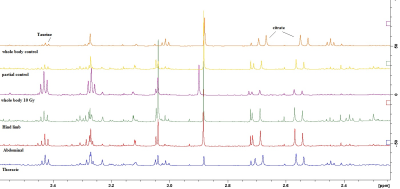 |
101 |
 Comparative NMR urine metabolomics of whole body or partial body radiation exposure: Stepping towards delivery of potent marker for radiation exposure Comparative NMR urine metabolomics of whole body or partial body radiation exposure: Stepping towards delivery of potent marker for radiation exposure
Poonam Rana, Ajaswrata Dutta, Sushant Mishra, Kiran Maan, Manju Gupta, Subash Khushu
Stepping forward towards the quest of high throughput radiation marker, the present study looks for a common signature on comparison of NMR based urine metabolomics post whole body or partial irradiation. Different group of animals were exposed to 10 Gy whole body or partial radiation. Irradiated group were clustered apart from controls; showed similar pattern on radiation exposure irrespective of whole body or cranial and identified taurine, citrate as common metabolites in whole body and partial radiation groups. The similar pattern observed post partial or whole body irradiation further confirm these metabolites as potent markers for radiation exposure.
|
|
4012.
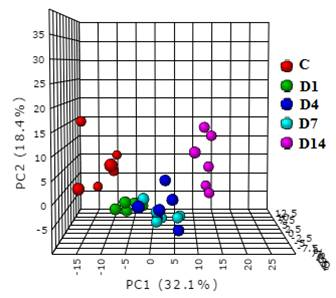 |
102 |
NMR based Metabonomics study of Chronic Cold Stress induced metabolic alterations in rat model
Did Not Present
SONIA GANDHI, SUBASH KHUSHU
Primary hypothermia/cold stress is due to environmental exposure, with no underlying medical condition causing disruption of temperature regulation. The exposure of human to such conditions often leads to decremented physical and mental performance. Metabonomics can provide a quick snapshot of exogenous/endogenous stressors induced metabolic perturbations. The metabolic pathways analysis showed that Taurine and TCA metabolism have maximum contribution to the altered urine metabolic phenotype. Metabolic markers related to liver dysfunction, gut microflora & muscle bioenergetics were altered due to cold exposure. These changes in combination with genomics and proteomics studies would further reveal potential drug targets contributing to cold exposure medicine.
|
|
4013.
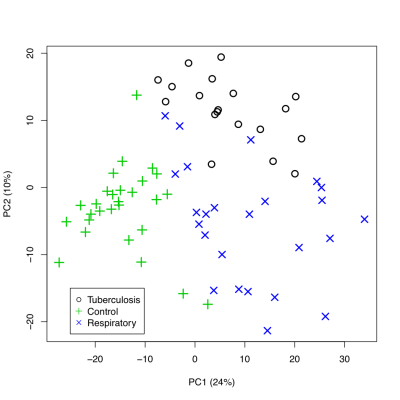 |
103 |
 NMR-BASED METABOLOMIC ANALYSIS AS A DIAGNOSTIC TOOL FOR TUBERCULOSIS IN CLINICAL URINE SAMPLES NMR-BASED METABOLOMIC ANALYSIS AS A DIAGNOSTIC TOOL FOR TUBERCULOSIS IN CLINICAL URINE SAMPLES
Jose Izquierdo-Garcia, Ramon Campos-Olivas, Mar Serra, Cristina Prat, Jose Dominguez, Jesus Ruiz-Cabello
The ability of diagnose the tuberculosis infection is an essential factor in the spreading control of tuberculosis. However, microscopic examination presents a low sensitivity and culture techinques require incubation times up to two months. This study aimed at developing a NMR-based metabolomic approach for the differential diagnosis of tuberculosis in urine samples. We examined samples from patients diagnosed of tuberculosis (n=19), other respiratory infection (n=25) and healthy controls (n=29). Unsupervised PCA provide a nearly perfect discrimination between the three groups. We identified 31 chemical shifts regions to develop predictive models for the diagnostic of tuberculosis, obteining an accuracy of 100%.
|
|
4014.
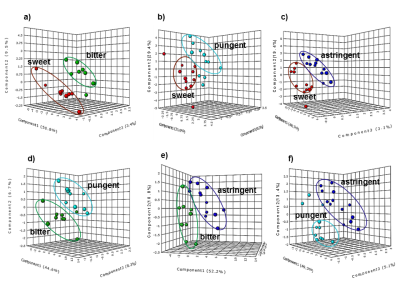 |
104 |
Targeted and untargeted NMR phytometabolomics for polar chemosensory markers and signatures
Video Permission Withheld
Aruna Singh, Dushyant Kumar, Rama Jayasundar
The potential of proton NMR metabolomics to classify medicinal and nutraceutical plants based on their chemosensory property such as taste has been explored in this study. Polar fractions obtained by dual phase (chloroform-methanol/water) extraction of select plants (n=48) from four chemosensory groups were studied using water suppressed 1D proton NMR spectroscopy. Untargeted metabolomics showed distinct chemosensory based clustering using Partial Least Square Discriminant Analysis. Using targeted metabolomics, chemosensory phytomarkers like α- and β- glucose (sweet), swertiamarin (bitter), trigonelline (pungent) and quercetin (astringent) were identified. The study has shown that NMR can play an important role in sensory science.
|
|
4015.
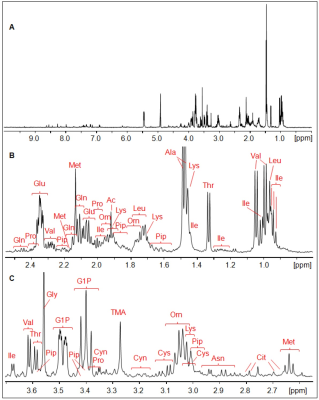 |
105 |
 Determination of the metabolome of Giardia lamblia by 1H Magic Angle Spinning NMR Determination of the metabolome of Giardia lamblia by 1H Magic Angle Spinning NMR
Martina Vermathen, Joachim Müller, Norbert Müller, Peter Vermathen
The intestinal protozoan parasite Giardia lamblia is a major cause of persistent diarrhea in humans and animals worldwide. Details concerning underlying metabolic pathways in Giardia are scarce and a methodology to study giardial intermediary and energy metabolism is required. Here, a high resolution magic angle spinning (HR-MAS) NMR study is presented determining the metabolic profile of G. lamblia trophozoites. This study builds the basis of following investigations on Giardia that are resistant against Metronidazole and other nitro compounds, which have been used since decades as therapy of choice against giardiasis.
|
|
4016.
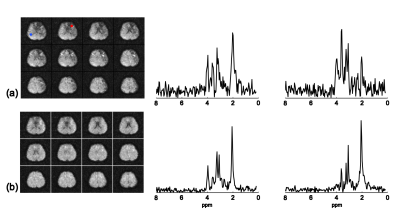 |
106 |
 Removal of Water Sidebands from 1H-MRSI Data Acquired without Water Suppression Removal of Water Sidebands from 1H-MRSI Data Acquired without Water Suppression
Yudu Li, Fan Lam, Rong Guo, Bryan Clifford, Xi Peng, Zhi-Pei Liang
The water sideband artifact is a major obstacle to proton MR spectroscopic imaging (1H-MRSI) without water suppression (WS). This work presents a novel method to remove the sideband artifacts from non-WS MRSI data, characterized by the use of a reference-based parametric model to represent the artifacts. Our method obtains the reference signal from two auxiliary scans and subsequently estimates the sideband signals from a particular MRSI data. The proposed method has been validated using both phantom and in vivo experimental data, demonstrating that it can effectively remove the sideband artifacts without introducing spectral distortion. This method is expected to be useful for many non-WS MRSI studies.
|
|
4017.
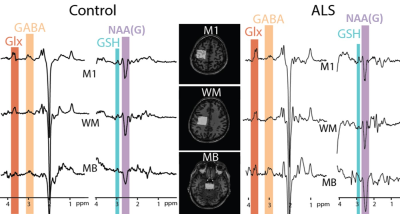 |
107 |
 Oxidative Stress and Neurotransmitters Imbalance in Amyotrophic Lateral Sclerosis Oxidative Stress and Neurotransmitters Imbalance in Amyotrophic Lateral Sclerosis
Mona Mohamed, Muhammad Saleh, Mark Mikkelsen , Kristen Riley, Jeffrey Rothstein, Lora Clawson, Peter Barker, Richard Edden
Amyotrophic lateral sclerosis (ALS) is a rapidly progressive and invariably fatal motor neuron disease. The objective of the study was to use the newly developed HERMES (Hadamard Encoding and Reconstruction of MEGA-Edited Spectroscopy) spectral editing methodology to simultaneously measure key compounds related to oxidative stress and glutamatergic metabolism (GSH, GABA, and Glx) in patients with ALS and control subjects. Using HERMES, we were able to look at different metabolic pathways in ALS in one MRS session. Improved understanding of the various metabolic pathways in ALS will lead to the development of new diagnostic surrogate markers and therapeutic approaches.
|
|
4018.
 |
108 |
 The effect of a 12-week aerobic exercise intervention on neurometabolites in young healthy adults using 7T 1H-MRS The effect of a 12-week aerobic exercise intervention on neurometabolites in young healthy adults using 7T 1H-MRS
Anouk Schrantee, Jannie Wijnen, Michelle Solleveld, Aart Nederveen, Serge Dumoulin, Dennis Klomp, Liesbeth Reneman, Paul Lucassen
Prolonged exercise has beneficial effects on cognition, which could be mediated by changes in neuronal metabolism. We present the first 7T MRS exercise study investigating neurometabolite concentrations before and after randomization to aerobic exercise or toning exercise in a large sample of healthy volunteers. We found that change in cardiovascular fitness was positively associated with changes in hippocampus glutamine, and negatively associated with change in glutamate in the anterior cingulate cortex; regardless of exercise group. This suggests that exercise-induced metabolic changes might not specific to the hippocampus, and that exercise likely has widespread effects on brain metabolism.
|
|
4019.
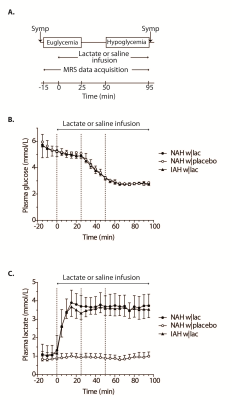 |
109 |
 Effect of lactate administration on brain lactate concentrations during hypoglycemia in patients with type 1 diabetes Effect of lactate administration on brain lactate concentrations during hypoglycemia in patients with type 1 diabetes
Evita Wiegers, Hanne Rooijackers, Cees Tack, Bart Philips, Arend Heerschap, Bastiaan de Galan, Marinette van der Graaf
Lactate administration during hypoglycemia suppresses counterregulatory responses, which mimicks the condition of impaired awareness of hypoglycemia (IAH) seen in patients with type 1 diabetes. Lactate can act as an alternative cerebral fuel and/or lactate can drive other brain-protective processes. We examined whether lactate administration affects brain lactate concentrations, as measured with J-difference editing 1H-MRS, during hypoglycemia in patients with normal awareness of hypoglycemia (NAH) and in patients with IAH. Brain lactate concentrations increased modestly upon lactate infusion in both groups. These results suggest that the excess lactate entering the brain is immediately oxidized, which may suppress the hypoglycemic counterregulatory response.
|
|
4020.
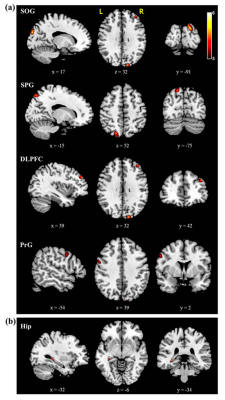 |
110 |
 Neurofunctional deficits and cellular metabolic changes associated with working memory dysfunction in patients with generalized anxiety disorder Neurofunctional deficits and cellular metabolic changes associated with working memory dysfunction in patients with generalized anxiety disorder
Chung-Man Moon, Gwang-Woo Jeong
Generalized anxiety disorder (GAD) negatively affects emotional regulation and cognitive function. However, the causality between neurofunctional and metabolic brain alterations is not clearly revealed since the brain function and metabolic studies have been independently performed. A combined fMRI and 1H-MRS study would be necessary to investigate whether both of the brain functional abnormality and the metabolic changes are associated with the emotional dysregulation and cognitive deficit in GAD. Therefore, the purpose of this study was to assess the association between neurofunctional deficits and cellular metabolic changes under working memory (WM) tasks in patients with GAD.
|
|
4021.
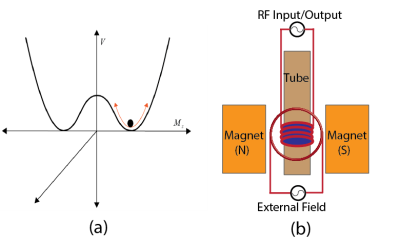 |
111 |
Signal Enhancement Under Explicit Field Perturbation in Magnetic Resonance Spectroscopy
Did Not Present
Dhiraj Sinha, Smitha Surendran
The current work presents a novel approach on signal enhancement in magnetic resonance spectroscopy through explicit field perturbatiobn. We have discovered that under certain conditions of artificial perturbation of the existing field, the output signal can be enhanced. The signal enhancement not only happens by increasing the magnitude of the external signal at the precession frequency but also by changing the frequency of the external field. The results have broad application not only in the field of magnetic resonance spectroscopy but also in magnetic resonance imaging.
|
|
4022.
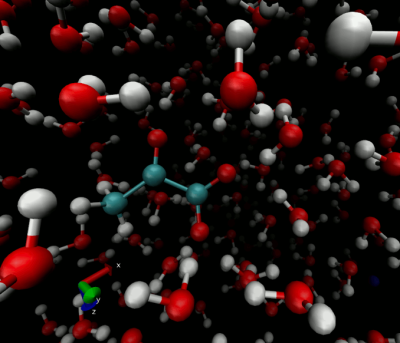 |
112 |
 Use of Ab-Initio Molecular Dynamics Simulations to Estimate Hyperpolarized 13C Agent Spin-Lattice Relaxation Times Use of Ab-Initio Molecular Dynamics Simulations to Estimate Hyperpolarized 13C Agent Spin-Lattice Relaxation Times
Joe Wildenberg, Stephen Kadlecek, Rahim Rizi, Terence Gade
We demonstrated the feasibility of using an ab-initio molecular dynamics simulation to estimate the T1 relaxation time constant of hyperpolarized 13C substrates. The utility of such predictive tools would provide further insight into specific relaxation mechanisms involved in various substrates, allowing us to evaluate candidate strategies to extend their T1 relaxation time constants. Such screening of candidate hyperpolarized agents may be used to rapidly assess polarizability of agents specific to various molecular pathways.
|
|
4023.
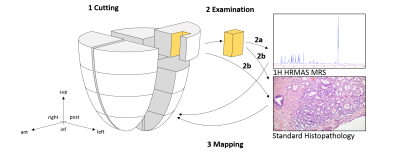 |
113 |
 A metabolomic evaluation of prostate cancer field effects A metabolomic evaluation of prostate cancer field effects
Sarah Dinges, Lindsey Vandergrift, Shulin Wu, Yannick Berker, Chin-Lee Wu, Piet Habbel, Leo Cheng
The gold standard in diagnosing prostate cancer (PCa) is pathological examination of biopsy cores. Still, false negative rates remain between 30-50%. Studies of cancer field effects suggest that tissue without histologically visualizable cancer cells has diagnostic value and could enlarge biopsy target regions. To map metabolic field effects in human prostates, we used HRMAS-MRS to analyze multiple tissue samples throughout entire removed cancer-positive prostates. Evaluation of metabolomic profiles of histologically-benign (Hb) tissue showed that Hb tissues at varying distances to PCa lesions have different metabolic profiles. Hb tissue enables differentiation between clinical parameters (Gleason Score, pathological stage, cancer-affected prostate %).
|
|
4024.
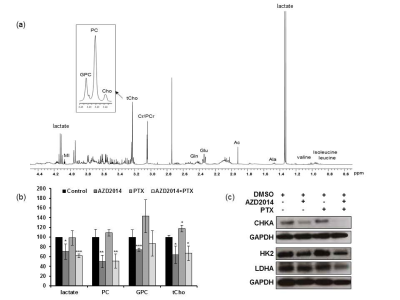 |
114 |
 In vitro NMR spectroscopy identifies metabolic changes resulting from addition of a novel anti-cancer agent (AZD2014) to standard treatment, guiding potential imaging approaches In vitro NMR spectroscopy identifies metabolic changes resulting from addition of a novel anti-cancer agent (AZD2014) to standard treatment, guiding potential imaging approaches
Nada Al-Saffar, Jasmin Sidhu, Udai Banerji, Yuen-Li Chung, Martin Leach
Previous reports showed that activation of the PI3K/mTOR pathway is associated with chemoresistance in ovarian cancer cells, and this can be reversed by combining chemotherapy with the mTORC1/2 inhibitor vistusertib (AZD2014). This combination is now being pursued clinically. In this study, we used NMR spectroscopy to establish biomarkers for this combination in A2780Cis human ovarian carcinoma cells. We report that this combination resulted in decreases in lactate, PC, GPC and tCho and was associated with inhibition of glycolysis- and choline-regulatory enzymes. This indicates that choline metabolites and lactate may provide potential non-invasive biomarkers of tumour response to this combination therapy.
|
|
4025.
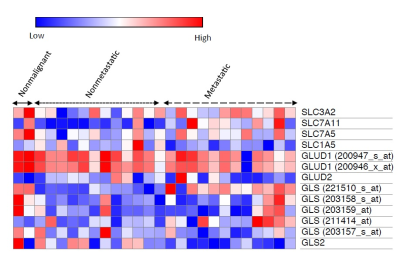 |
115 |
 Exploring Glutamate and Glutamine Metabolism Across Breast Cancer Subtypes using High-resolution Proton MRS Combined with Molecular Approaches Exploring Glutamate and Glutamine Metabolism Across Breast Cancer Subtypes using High-resolution Proton MRS Combined with Molecular Approaches
Caitlin Tressler, Vinay Ayyappan, Kristine Glunde
We have studied glutamine metabolism in a panel of breast cancer cell types to examine the utilization of glutamine as an energy source in different subtypes of breast cancer. We utilized high-resolution 1H MRS detection of glutamine and glutamate from cell extracts to determine up regulation of glutamine metabolism as a whole followed by quantitative RT-PCR to begin to establish the critical pathways involved in altered glutamine metabolism within malignant cell types. Altered glutamine metabolite signatures may be used to identify malignancy within cells and key enzymes in glutamine metabolism may prove to be potential therapeutic targets.
|
|
4026.
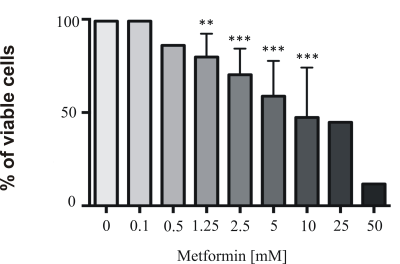 |
116 |
MRS-based metabolomic approaches detect multiple metabolic targets for the antitumor action of metformin on U87MG glioma cells.
Video Permission Withheld
Marco Rinaudo, Agnese Sacchetti, Serena Cecchetti, Laura Mercurio, Maria Jose Caramujo, Mattea Chirico, Marika Pinazza, Giulia Carpinelli, Stefano Indraccolo, Franca Podo, Egidio Iorio
There is an urgent need to develop novel therapeutic strategies for malignant brain tumors. Purposes of this study were: 1) to investigate in glioma cells the alterations induced by metformin in the levels of metabolites produced by different biochemical pathways ( glycolysis and phosphatidylcholine (PC) metabolism); 2) to evaluate the possibility to enhance the antiproliferative effects of metformin by a combination of metformin with a selected inhibitor of PC metabolism. We found : a) activation of PC-plc and PCho accumulation in metformin-treated cells; b) enhanced cell death in glioma cells with a combination of metformin and the PC-plc.
|
|
4027.
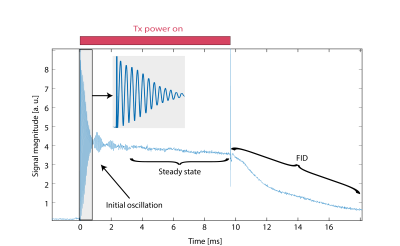 |
117 |
 Probehead design for multi-photon NMR induced homonuclear continuous RF decoupling Probehead design for multi-photon NMR induced homonuclear continuous RF decoupling
Christoph Schildknecht, David Brunner, Klaas Pruessmann
Spectra of strongly coupled nuclear systems are frequently obtained by fast magic angle spinning. In biological samples, this is often not feasible, leaving homonuclear RF decoupling as the only alternative. This approach requires fast nutation while receiving a spectrum from the same type of nuclei. This can be achieved by multi-photon excitation, albeit at the expense of high power densities. In this work, we present a construction approach for such probe heads maximizing the excitation efficiency and demonstrating nutations above 20kHz over extended periods of time.
|
|
4028.
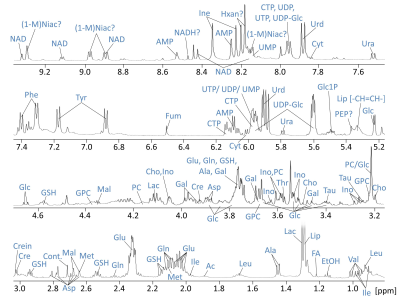 |
118 |
 Investigation of bioenergetic adaptations under galactose stress in OXPHOS deficient fibroblasts using a combined metabolic Flux and HR-MAS NMR approach Investigation of bioenergetic adaptations under galactose stress in OXPHOS deficient fibroblasts using a combined metabolic Flux and HR-MAS NMR approach
Damian Hertig, Andrea Debora Felser, Gaëlle Diserens, Sandra Kurth, Peter Vermathen, Jean-Marc Nuoffer
Defects in the mitochondrial OXPHOS lead to an extremely heterogeneous group of disorders and common laboratory screening methods are prone to misinterpretations. In this study we report metabolic adaptation of OXPHOS deficient human skin fibroblasts during galactose stress condition. We report a rapid HR-MAS NMR based method for the relative quantification of untargeted metabolome profiling providing containment of over 40 metabolites, which allowed us to observe unique cellular metabolic profiles in OXPHOS deficient fibroblast.
|
|
4029.
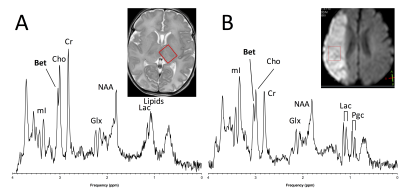 |
119 |
 Betaine detection in human brain Betaine detection in human brain
Stefan Bluml, Jessica Wisnowski, Marvin Nelson, Tai-Wei Wu
Betaine, an essential osmolyte and source of methyl groups, is a metabolite known to be present in brain. However, due to its low concentrations and its overlap with the choline signal, betaine detection and quantitation is difficulty. In this study, we quantified betaine in high-quality spectra of pediatric patients and controls. The measured betaine concentrations of 0.1 - 0.2 mM are consistent with what has been measured in rat brain extracts by high-field NMR.
|
|
4030.
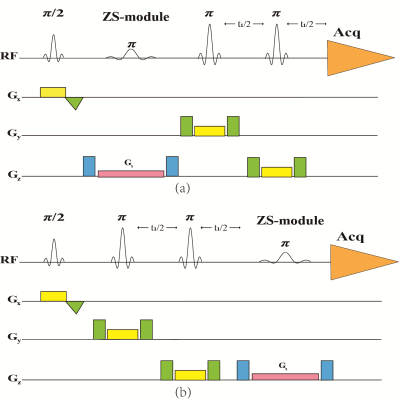 |
120 |
 High resolution localized 2D JPRESS spectroscopy with absorption-mode lineshape High resolution localized 2D JPRESS spectroscopy with absorption-mode lineshape
Lin Yanqin, Dan Tian, Bo Duan, Qing Zeng, Zhong Chen
Localized two-dimensional J-resolved spectroscopy (JPRESS) has been employed in the study of a number of diseases. However, phase-twisted lineshape and broad dispersion tails of magnitude peaks limit its usefulness. Here, a method based on the combination of JPRESS and anti-JPRESS alike spectra is proposed to remove the dispersive parts of the phase-twisted and to give absorption-mode JPRESS spectroscopy. This can double the resolution of JPRESS spectra at the cost of greatly reduced sensitivity. The method was performed with a phantom on a 7T animal scanner.
|
|
| Back |
| The International Society for Magnetic Resonance in Medicine is accredited by the Accreditation Council for Continuing Medical Education to provide continuing medical education for physicians. |


















































































































































